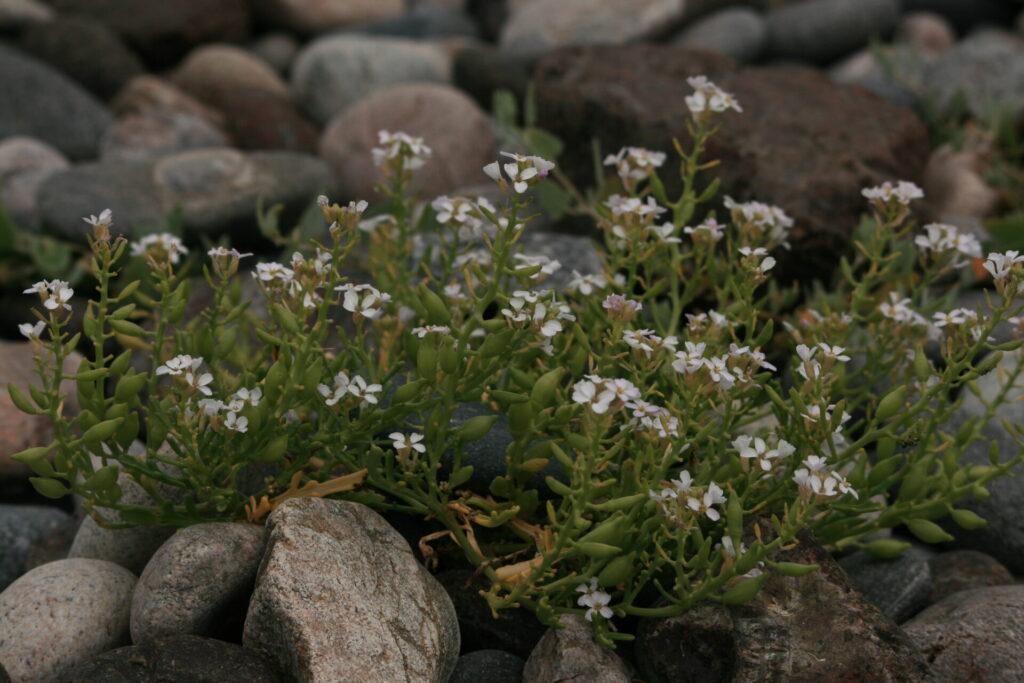
In Part 3, I will write about the pink and/or white flowered Crucifers which inhabit these Isles.
I follow the order of The Wild Flower Key as this has useful pictures which make identifying this somewhat unfamiliar and confusing family a lot easier!
I use the Online Atlas of the British and Irish Flora link on the First, italic, scientific names, so you can find out where it is likely to be found growing in the wild. You can also find other useful information here, especially its growing habitat and conditions!
On the Common Name link you can also find more information as well as useful pictures. Pictures in this post are by Matt Summers, Mike Poulton and sourced through Wikipedia Common with thanks.
Please use Jump-links in contents to read more about the individual genera & species on the next page!
Contents:
Group 5: Pink and/or white flowered Crucifers with elongated fruits.
Matthiola, Hesperis, Cakile & Lunaria
- Matthiola incana or Hoary Stock
- Matthiola sinuata or Sea Stock
- Hesperis matronalis or Dame’s-violet
- Cakile maritima or Sea Rocket
- Lunaria annua or Honesty
Cardamine
- Cardamine bulbifera or Coralroot
- Cardamine pratensis or Cuckooflower (Lady’s-smock)
- Cardamine flexuosa or Wavy Bitter-cress
- Cardamine hirsuta or Hairy Bitter-cress
- Cardamine impatiens or Narrow-leaved Bitter-cress
- Cardamine amara or Large Bitter-cress
Nasturtium
- Nasturtium officinale or Water-cress
- Nasturtium microphyllum or Narrow-fruited Water-cress
Arabis & Arabidopsis
- Arabis hirsuta or Hairy Rock-cress
- Arabis alpina or Alpine Rock-cress
- Arabis scabra or Bristol Rock-cress
- Arabidopsis petraea or Northern Rock-cress
- Arabidopsis thaliana or Thale Cress
Alliaria petiolata or Jack-by-the-Hedge/ Garlic Mustard
Draba & Drabella
- Draba incana or Hoary Whitlowgrass
- Draba norvegica or Rock Whitlowgrass
- Draba aizoides or Yellow Whitlowgrass
- Drabella muralis or Wall Whitlowgrass
Group 6: White flowered Crucifers with short fruits
Microthlaspi, Noccaea and Thlaspi
- Microthlaspi perfoliatum or Cotswold (Perfoliate) Penny-cress
- Noccaea caerulescens or Alpine Penny-cress
- Thlaspi arvense or Field Penny-cress
Lepidium
- Lepidium campestre or Field Pepperwort
- Lepidium heterophyllum or Smith’s Pepperwort
- Lepidium sativum or Garden Cress
- Lepidium ruderale or Narrow-leaved Pepperwort
- Lepidium draba or Hoary Cress
- Lepidium latifolium or Dittander
- Lepidium coronopus or Swine-cress
- Lepidium didymum or Lesser Swine-cress
TEESDALIA
- Teesdalia nudicaulis or Shepard’s Cress
Capsella, Iberis, Erophila
- Capsella bursa-pastoris or Shepard’s-purse
- Iberis amara or Wild Candytuft
- Erophila verna or Common Whitlowgrass
Cochlearia, Lobularia, Hornungia
- Cochlearia officinalis agg or Common Scurvygrass
- Cochlearia danica or Danish scurvygrass
- Cochlearica anglica or English Scurvygrass/ Long-leaved Scurvygrass
- Lobularia maritima or Sweet Alison
- Hornungia petraea or Hutchinsia
Group 7: White flowered Crucifers with very large leaves
Crambe & Armoracia
- Crambe maritima or Sea-kale
- Armoracia rusticana or Horse-radish
Group 5: Pink and/or white flowered Crucifers with elongated fruits.
Matthiola
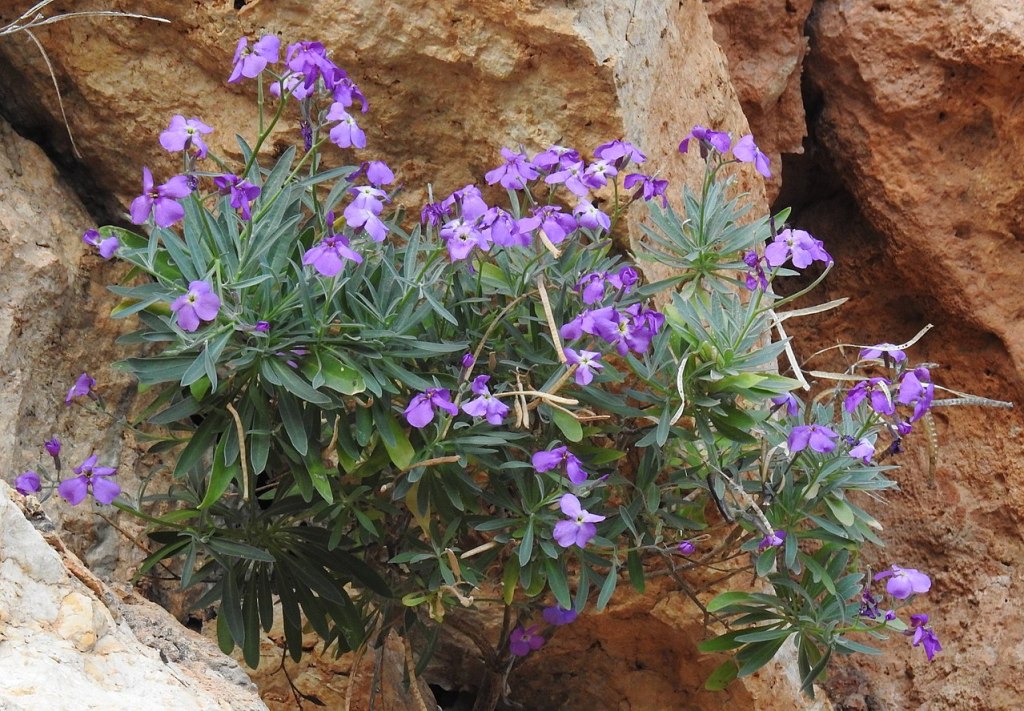
Matthiola incana or Hoary Stock
A short-lived perennial, well-naturalised on sea-cliffs, shingle and other habitats by the sea, and occasionally inland where it is more obviously a garden escape.
It is considered a Neophyte and has been widely cultivated in Britain since at least 1596, but may have been introduced long before that date. It has been considered to be native, but it was not recorded in the wild until 1808.
- It is a highly fragrant cut flower and colourful plant for the garden and in pots.
- Flowers and seedpods cab be eaten as a vegetable or used as a garnish, especially with sweet desserts. Used as a famine food when all else fails.
- A dark blue or purple dye is obtained from the flowers.
An infusion has been used in the treatment of cancer and when mixed with wine it has been used as an antidote to poisonous bites.
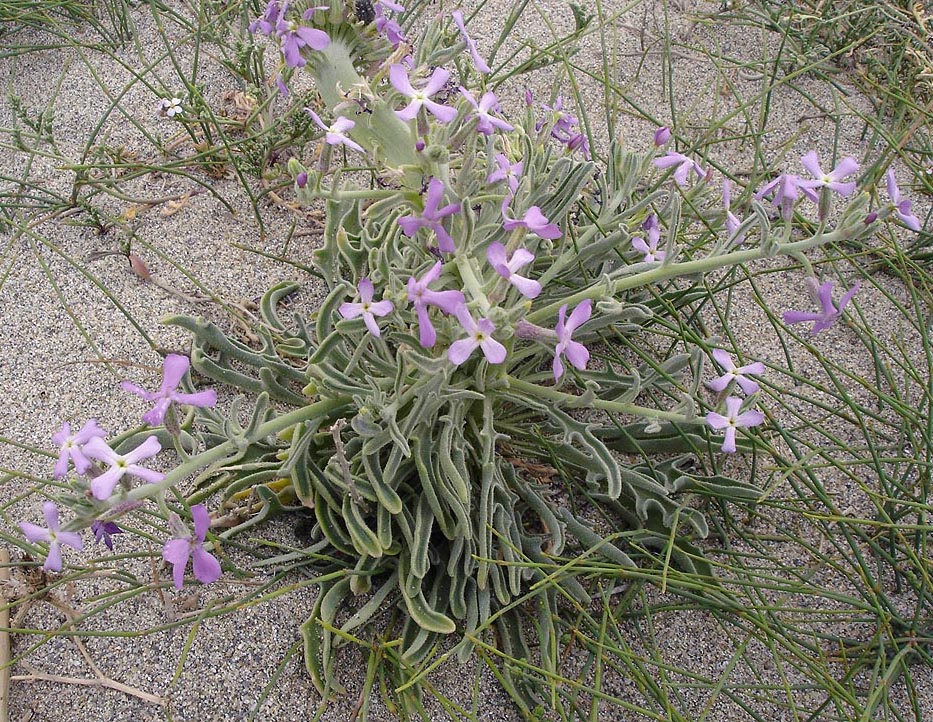
Matthiola sinuata or Sea Stock
A biennial or short-lived perennial herb of sand dunes and sea-cliffs. Most colonies are on young, fairly mobile dunes, and it has probably spread in the past by seeds floating in sea-water to new sites.
“This rare British native plant hold sprays of beautiful, fragrant, lavender-pink flowers from early summer onwards. Grey-green, flowering stems arise from an impressive rosette of grey, scallop-edged leaves. Grown in sand or well-drained soil.”
Hesperis
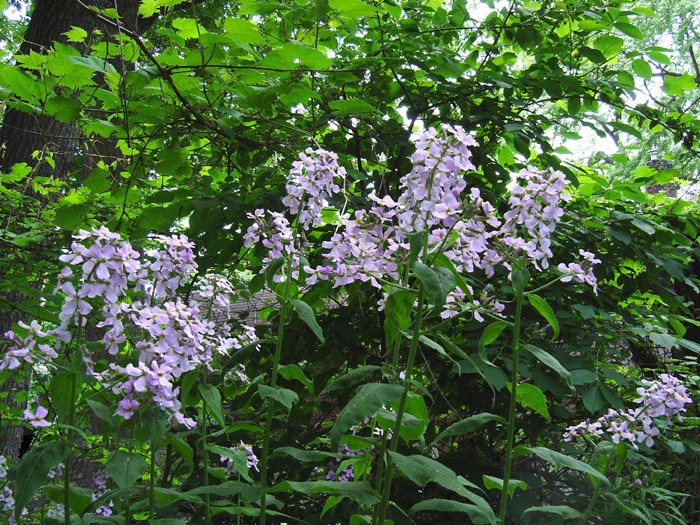
Hesperis matronalis or Dame’s-violet
A perennial, or sometimes biennial, herb of shaded moist habitats, found in hedgerows and wood borders, on river-banks, roadsides and waste ground, usually near habitation.
Classed as a Neophyte, H. matronalis has been cultivated in gardens since at least 1375 (Harvey, 1981), and was known in the wild by 1805.
Cakile
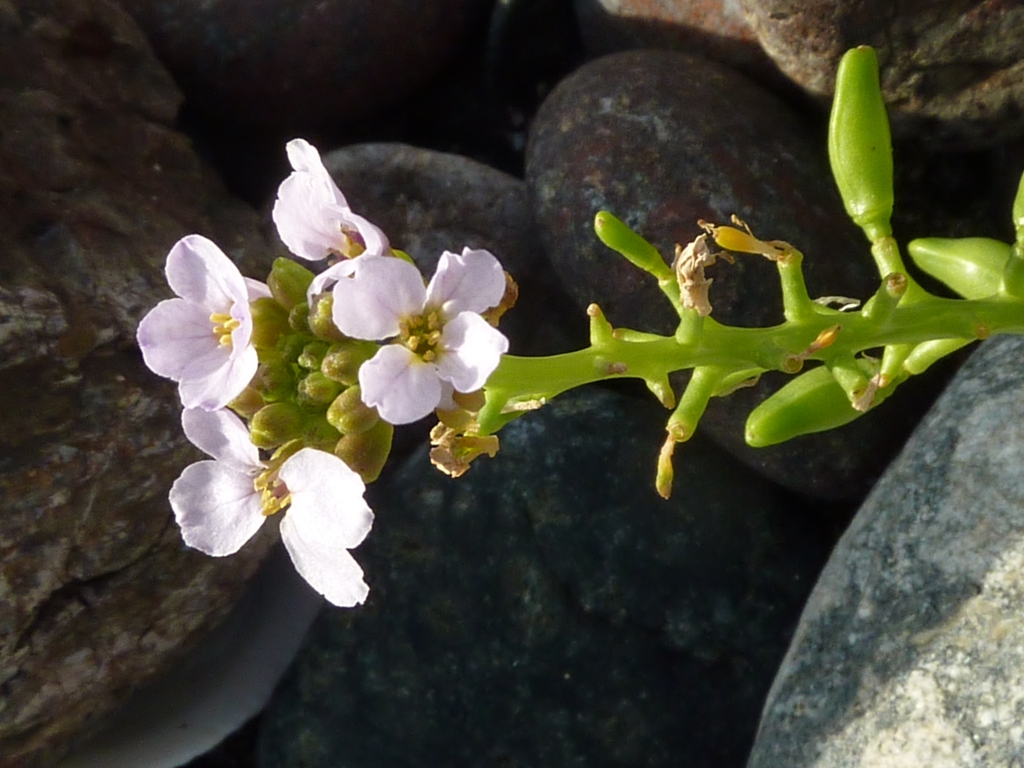
Cakile maritima or Sea Rocket
An annual, predominately found on sandy seashores and on fore-dunes. It is often very frequent along the winter storm tide-line where there is a good source of nutrients. It is rarer on shingle beaches and is only an occasional casual elsewhere. Seeds are dispersed by tides.
Leaves, stems, flower buds and immature seedpods – raw or cooked. They are rich in vitamin C but have a very bitter taste. Used mainly as a flavouring. Very young leaves can be added to salads whilst older leaves can be mixed with milder tasting leaves and used as a potherb. Root – dried and ground into a powder, then mixed with cereal flours and used to make bread. The seed contains a fatty oil.
Lunaria
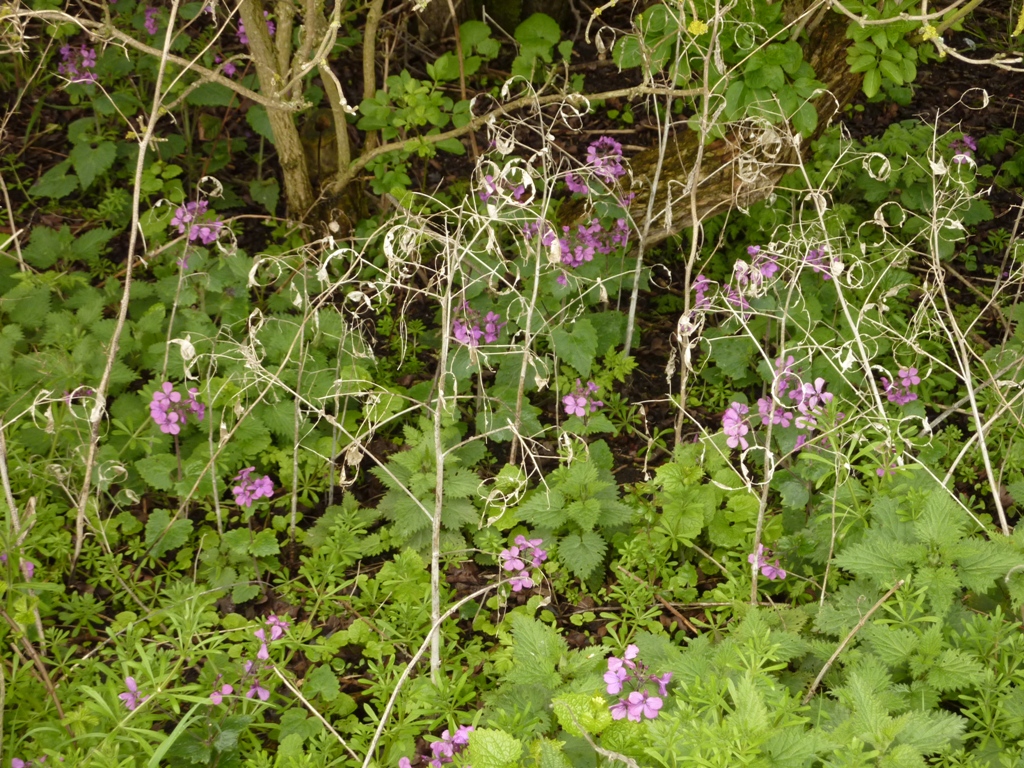
Lunaria annua or Honesty
A biennial herb, found naturalised near habitations on scrubby banks, beside paths, in hedgerows and secondary woodland, and on waste ground.
L. annua has been cultivated in Britain since at least 1570. It was known from the wild by 1597 and is therefore classified as a Neophyte.
The Latin name lunaria means “moon-shaped” and refers to the shape and appearance of this species’ silicles. The common name “honesty” arose in the 16th century, and may also relate to the translucence of its silicle membranes.
In South East Asia, it is called the “money plant” and in the United States it is commonly known as “silver dollars”, “Chinese money”, or “Chinese coins” because its silicle membranes have the appearance of silvery coins. For the same reason, in French it is known as monnaie du pape (“Pope’s money”). In Denmark it is known as judaspenge and in Dutch-speaking countries as judaspenning (both meaning “coins of Judas”), an allusion to the story of Judas Iscariot and the thirty pieces of silver he was paid for betraying Christ.
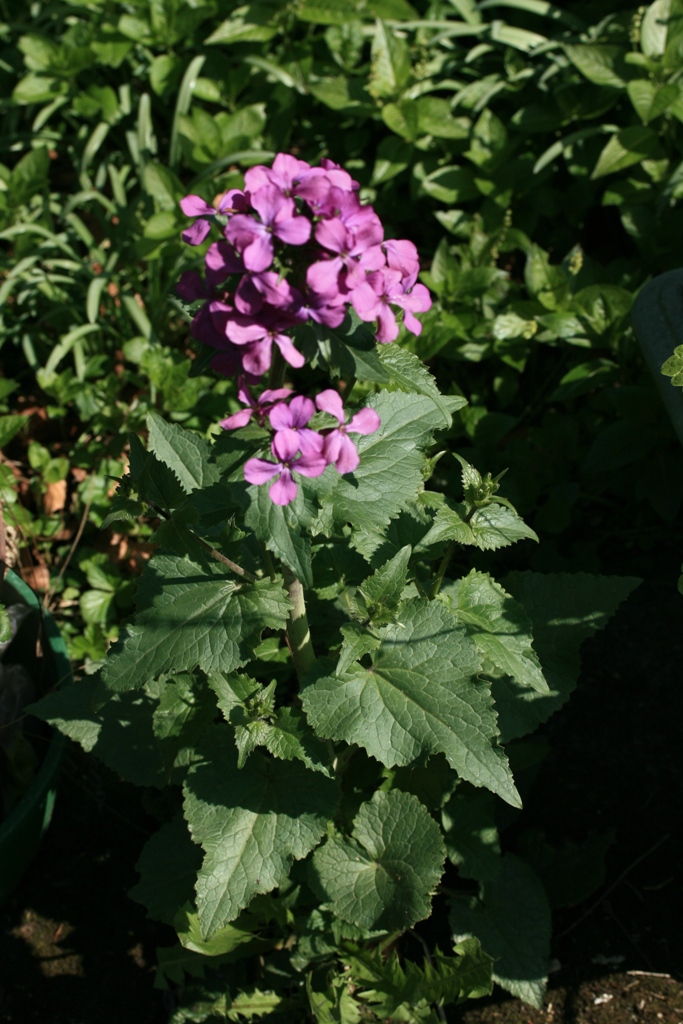

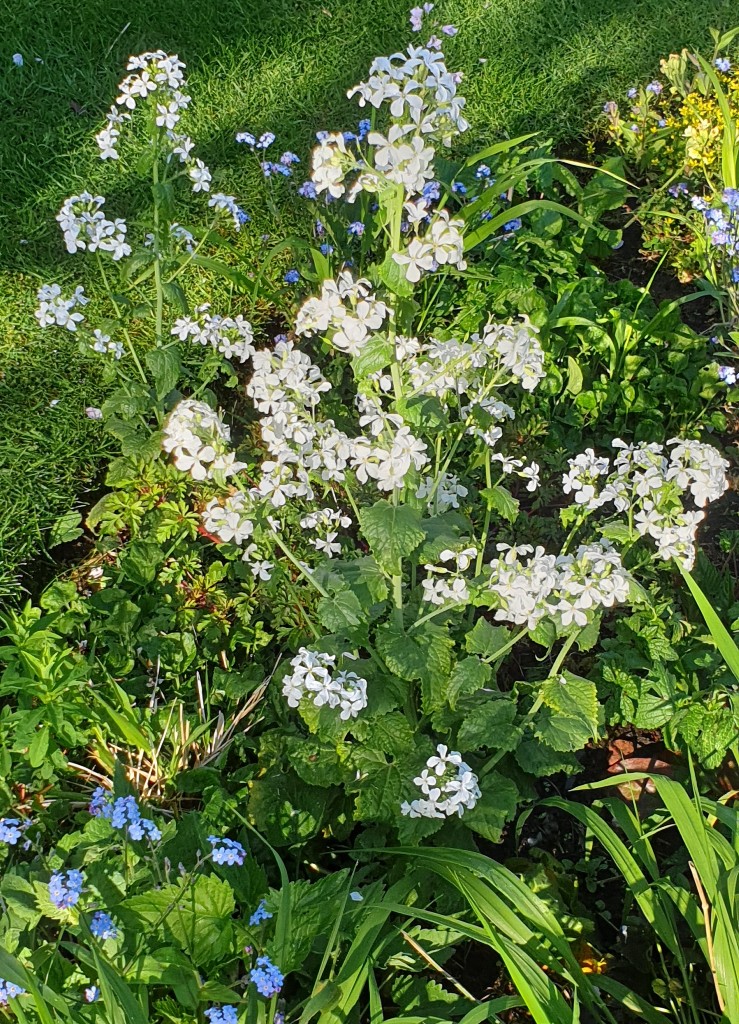
This is an attractive plant for a woodland garden, flowering in spring and leaving us with papery fruits during the dark winter months! Numerous varieties and cultivars are available, of which the white-flowered L. annua var. albiflora and the variegated white L. alba var. albiflora ‘Alba Variegata’ have won the Royal Horticultural Society‘s Award of Garden Merit.
Cardamine
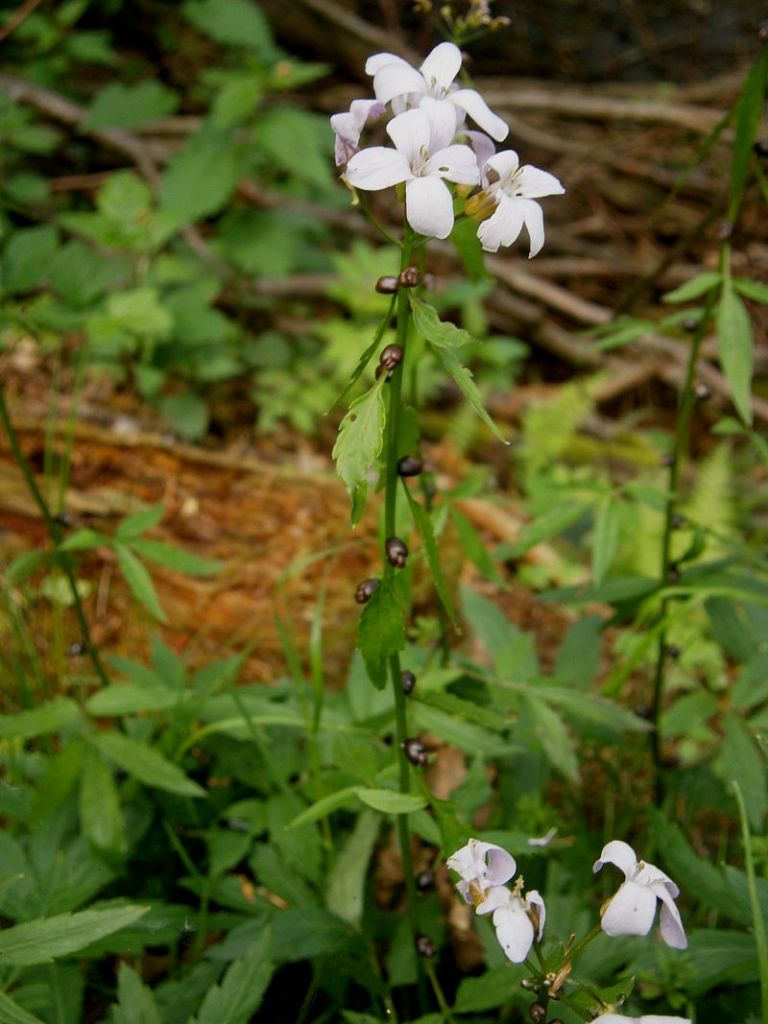
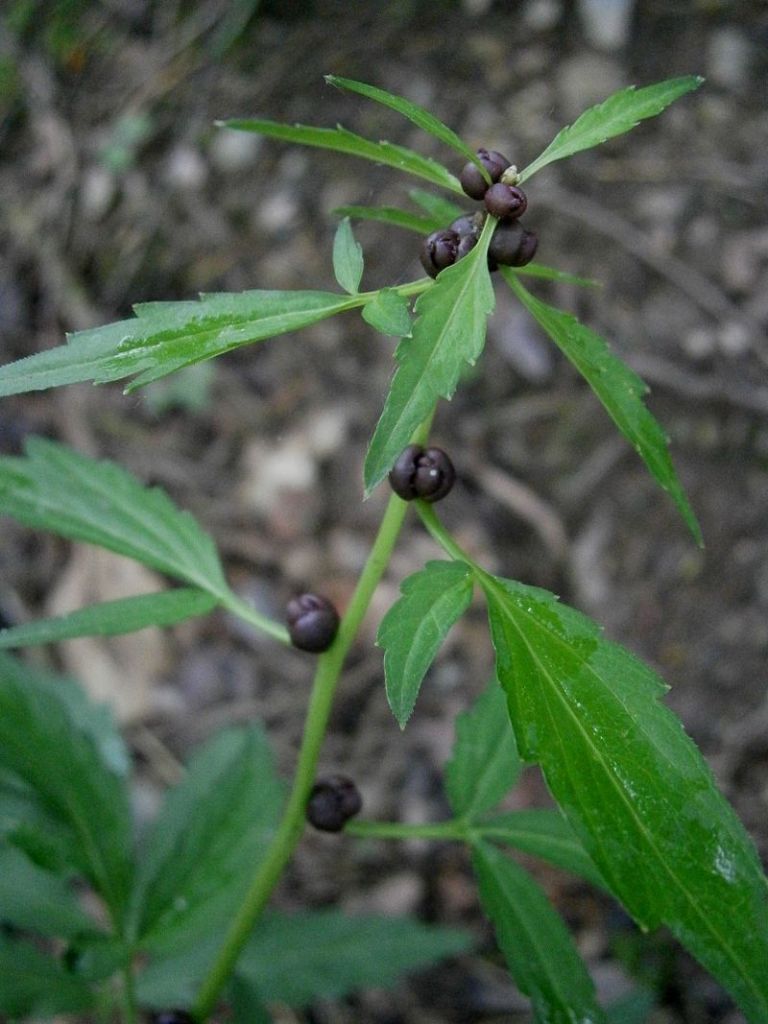
Cardamine bulbifera or Coralroot
A rhizomatous perennial herb which grows in Britain in two habitats: on dry woodland slopes over chalk in the Chilterns, and in damp woodlands over clay in the Weald.
Leaves – raw or cooked[K]. A hot cress-like flavour. Bulbils – raw or cooked. They are rather small, about the size of a lentil, but have a pleasant mild cress-like flavour[K]. Root – raw or cooked[K]. A hot flavour, it is pleasant but rather small[K].

Cardamine pratensis or Cuckooflower (Lady’s-smock)
A perennial herb of wet grassy places on moderately fertile, seasonally waterlogged soils in woods, wet meadows, fens and flushes. In upland areas it is also found in rush pasture and bryophyte-rich springs. It occasionally persists in gardens and lawns.
It is grown as an ornamental plant in gardens, and has become naturalised in North America as a result of cultivation. In some European countries, including parts of Germany, the plant is now under threat.
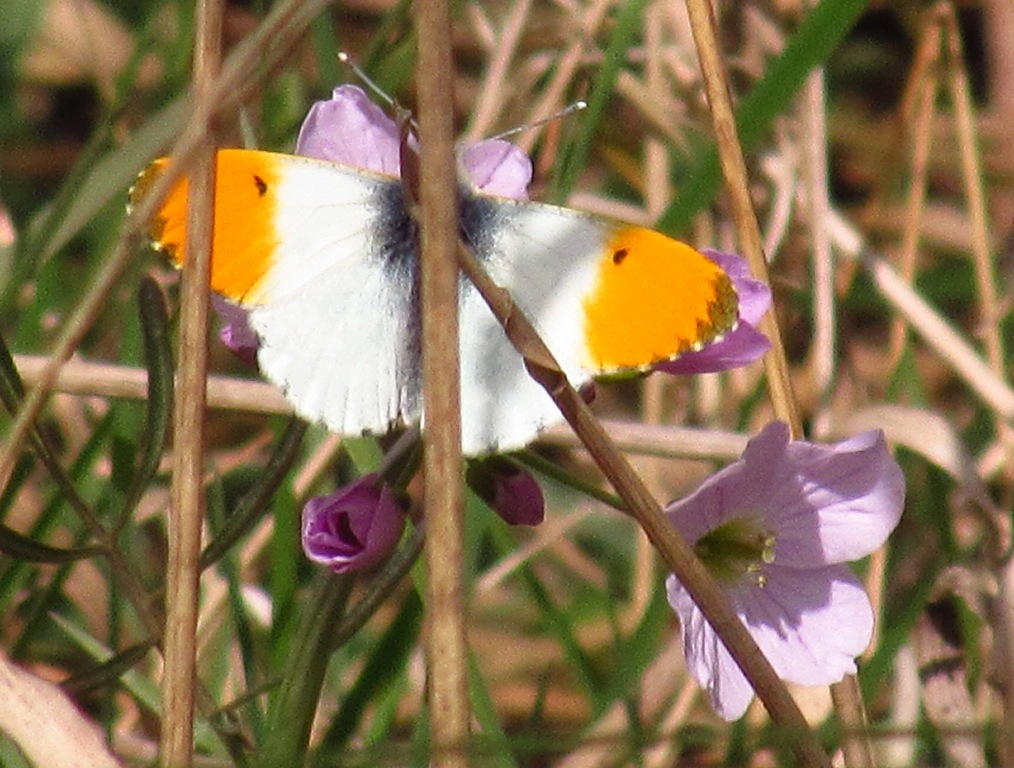

It is a food plant for the orange tip butterfly (Anthocharis cardamines) and makes a valuable addition to any garden which aims at attracting wildlife.
Leaves and young shoots can be eaten raw or cooked. Rich in vitamins and minerals, especially vitamin C, but with a bitter and pungent flavour. The leaves and young shoots are harvested in the spring and taste rather like watercress. The leaves can be available early in the year[K] and when used in small quantities make a very acceptable addition to salads. Flowers and flower buds – raw. A pungent cress-like flavour[K]. The lilac flowers are very attractive, they make a pleasant nibble and also add a delicious flavour to salads[K].
Cuckoo flower is seldom used in herbalism, though an infusion of the leaves has been used to treat indigestion and promote appetite. The leaves and the flowering plant are used internally in the treatment of chronic skin complaints, asthma and hysteria. The plant is harvested in spring and early summer and is best used when fresh.

Cardamine flexuosa or Wavy Bitter-cress
A winter- or summer-annual, or rarely a short-lived perennial, most frequent in open, moist, shaded vegetation in marshland, by rivers and streams, and in gardens. It prefers soils which are at least mildly basic, and is absent from those that are strongly acidic. It is an effective colonist of disturbed, fertile habitats.
Leaves and Rot can be eaten raw or cooked. A hot cress-like flavour. Nice as a flavouring in salads, it is usually available all year round.
In Northeast Indian State, Manipur, it is eaten and often used as garnishing Eromba and known as Chaantruk.

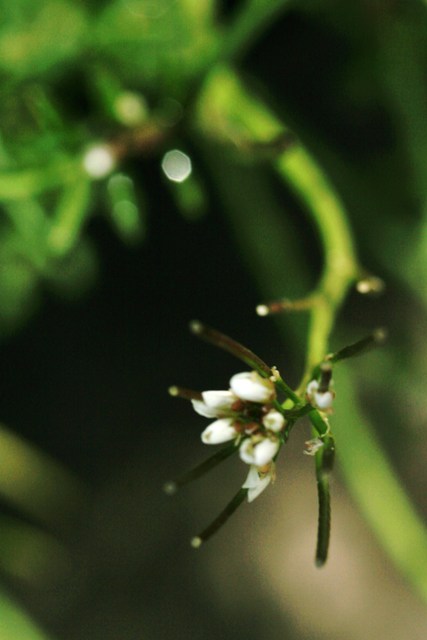
Cardamine hirsuta or Hairy Bitter-cress
A winter-annual which, under favourable conditions, can flower and seed again in autumn. C. hirsuta is particularly common as a weed of cultivation and in other ruderal habitats, but it also grows on rock outcrops, by streams and in woods.
Edible Uses:
Leaves and flowers – raw or cooked. A hot cress-like flavour, they are mainly used as a garnish or flavouring in salads etc but are also sometimes used as a potherb. The plant germinates most freely in the autumn and so leaves are usually available all winter.
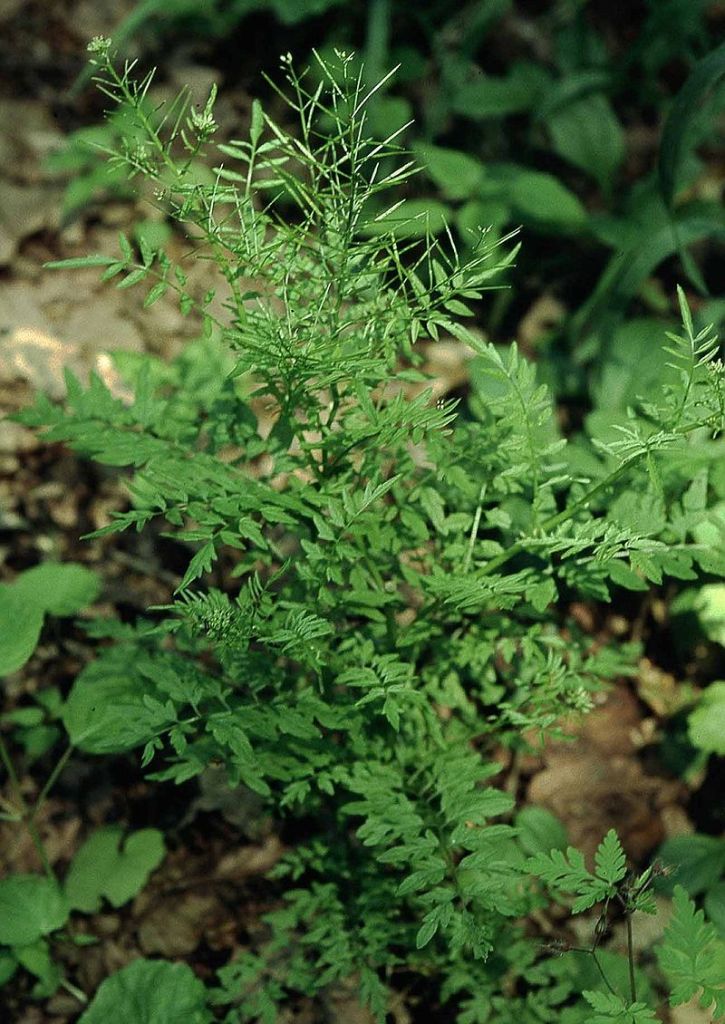
Cardamine impatiens or Narrow-leaved Bitter-cress
A biennial herb found in woodland (particularly under Fraxinus), on moist limestone rocks (including the grikes of limestone pavement) and stable screes, by rivers and on damp roadsides; rarely found as a garden escape. It is intolerant of competition, but can be invasive in recently disturbed habitats.
Leaves and young shoots – raw or cooked. Used as a vegetable.
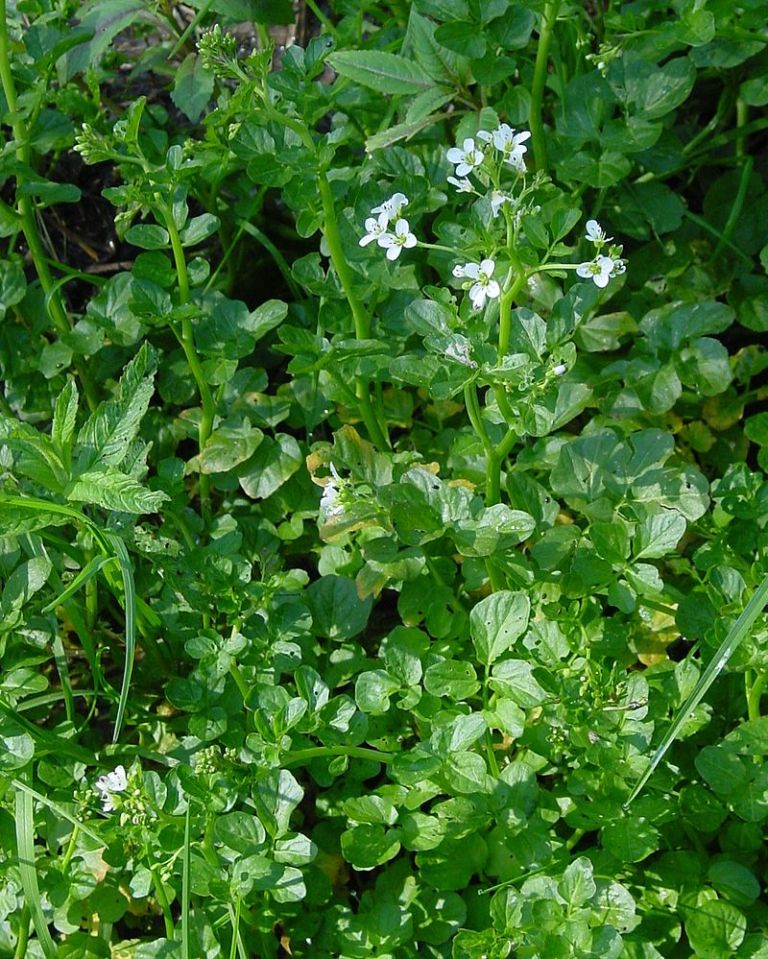
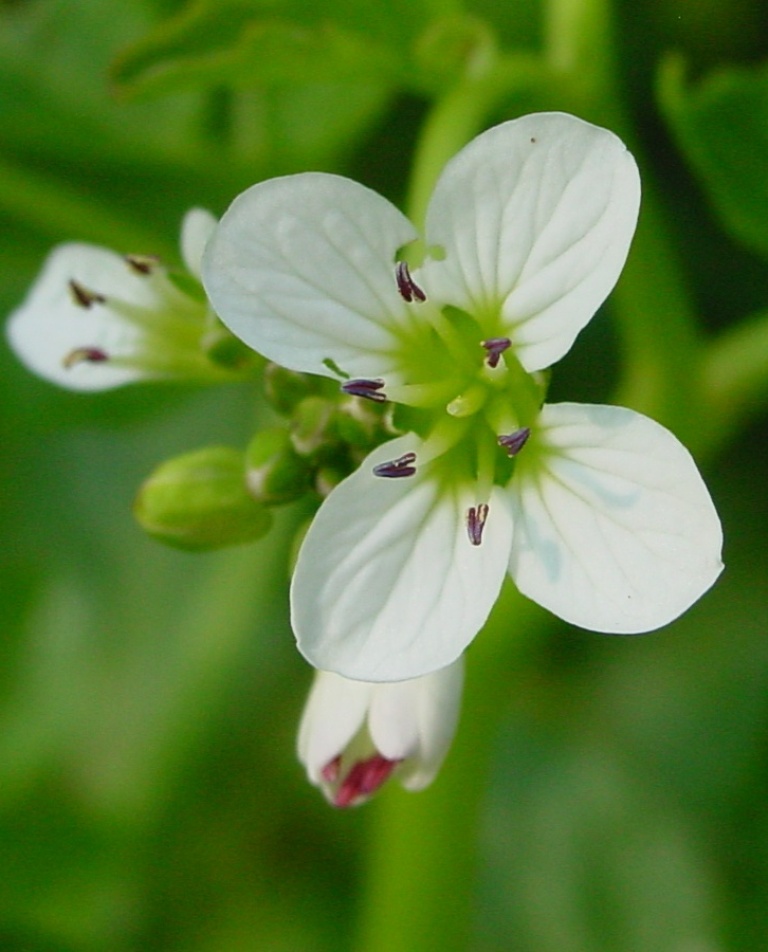
Cardamine amara or Large Bitter-cress
A perennial winter-green herb of streamsides and marshes, wet meadows and wet woodland, often growing in slow-moving or still water, preferring an acidic substrate and tolerant of shade.
Leaves – raw. A hot cress-like flavour, nice in small quantities in a salad and available all year round in most years[K]. A somewhat bitter flavour.
Medicinal Uses for probably most of the Cardamine ssp:
Antiscorbutic, diuretic and stimulant. (See link to explain the medical uses of plants by PFAF.)
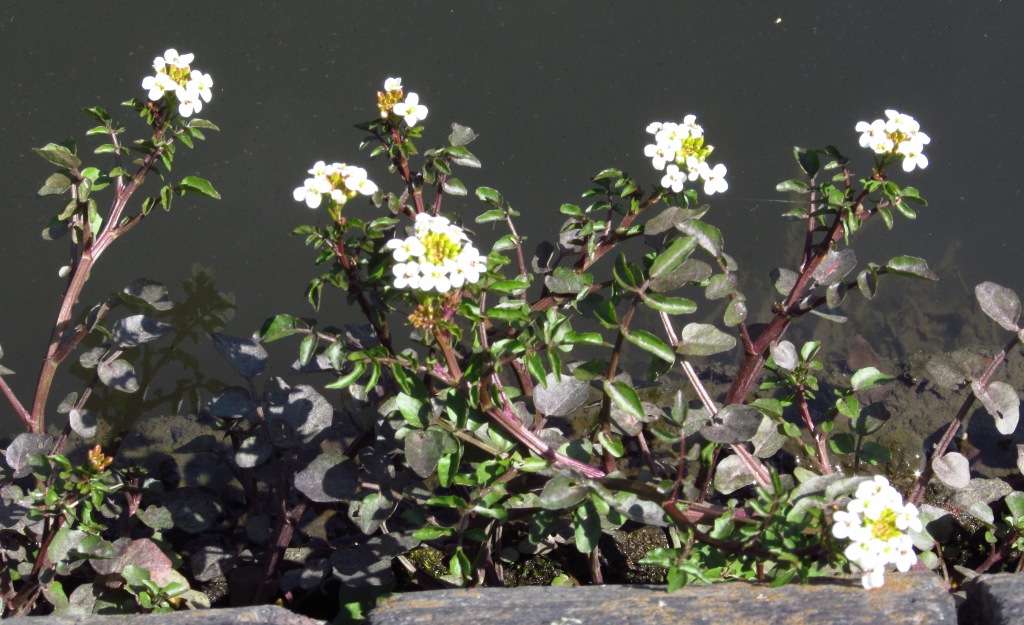
Nasturtium officinale or Water-cress
A perennial herb, found both in and beside clear shallow streams and in ditches, ponds, canals and marshes. Although it grows in similar habitats to R. microphylla, it tends to be restricted to calcareous substrates. It is also cultivated, but not as often as R. x sterilis.
Whilst the plant is very wholesome and nutritious, some care should be taken if harvesting it from the wild. Any plants growing in water that drains from fields where animals, particularly sheep, graze should not be used raw. This is due to the risk of it being infested with the liver fluke parasite. Cooking the leaves, however, will destroy any parasites and render the plant perfectly safe to eat. May inhibit the metabolism of paracetamol.
- Leaves of water cress are mainly used as a garnish or as an addition to salads, the flavour is strong with a characteristic hotness.
It has a reputation as a spring tonic, and this is its main season of use, though it can be harvested for most of the year and can give 10 pickings annually. Some caution is advised if gathering the plant from the wild, see the notes above on toxicity. The leaves are exceptionally rich in vitamins and minerals, especially iron.
- The seed can be sprouted and eaten in salads.
- The seed is ground into a powder and used as a mustard.

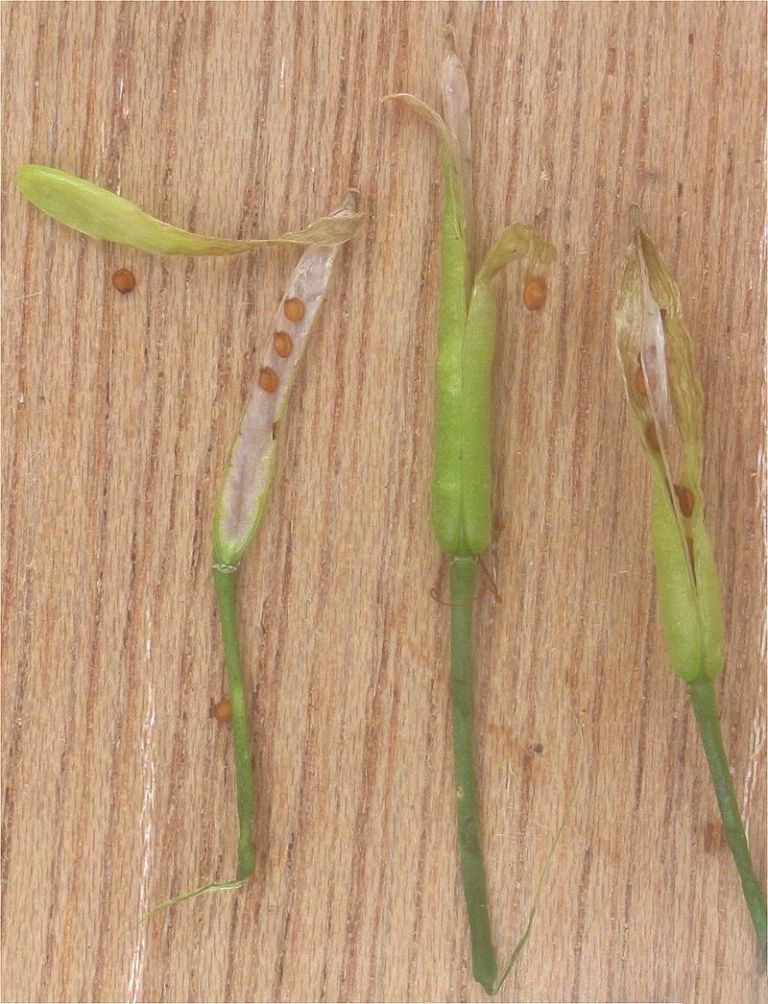
Nasturtium microphyllum or Narrow-fruited Water-cress
A perennial herb growing in and beside streams, ditches, ponds and canals, and in marshes. This species extends into rather more acidic sites than R. nasturtium-aquaticum, and in some areas is the most common segregate on non-calcareous soils.
Arabis
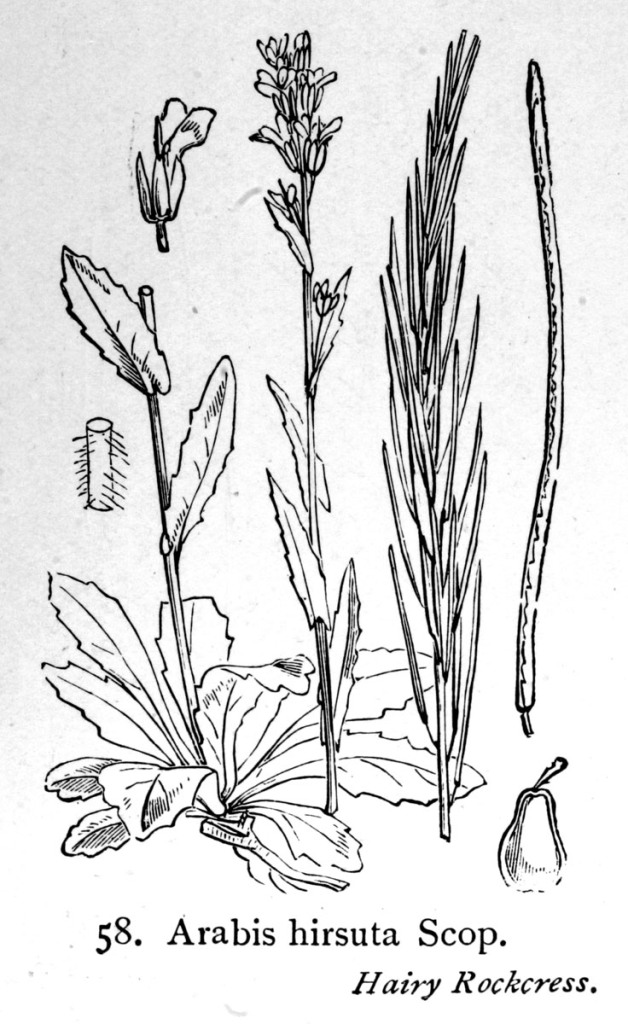
Arabis hirsuta or Hairy Rock-cress
A biennial or perennial herb growing in dry, sunny, exposed situations on rock outcrops and in grassland on base-rich substrates, particularly chalk and limestone; also occurring on sand dunes and on bridges and walls.
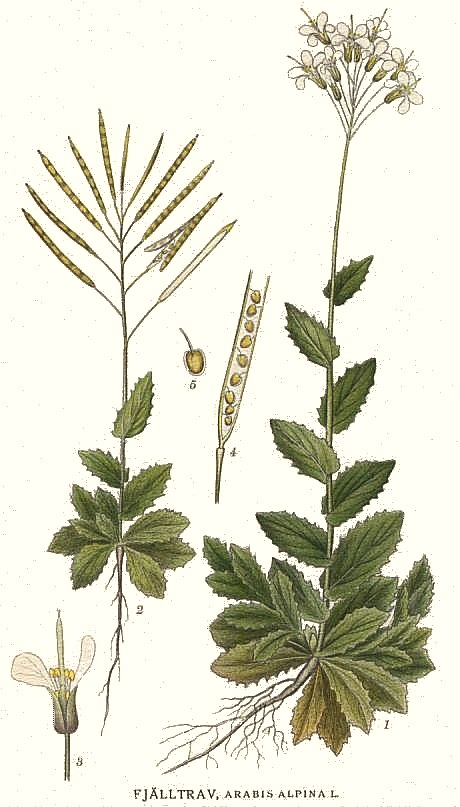
Arabis alpina or Alpine Rock-cress
A perennial, mat-forming herb of shaded ledges on basic cliffs. It is also a very rare garden escape.
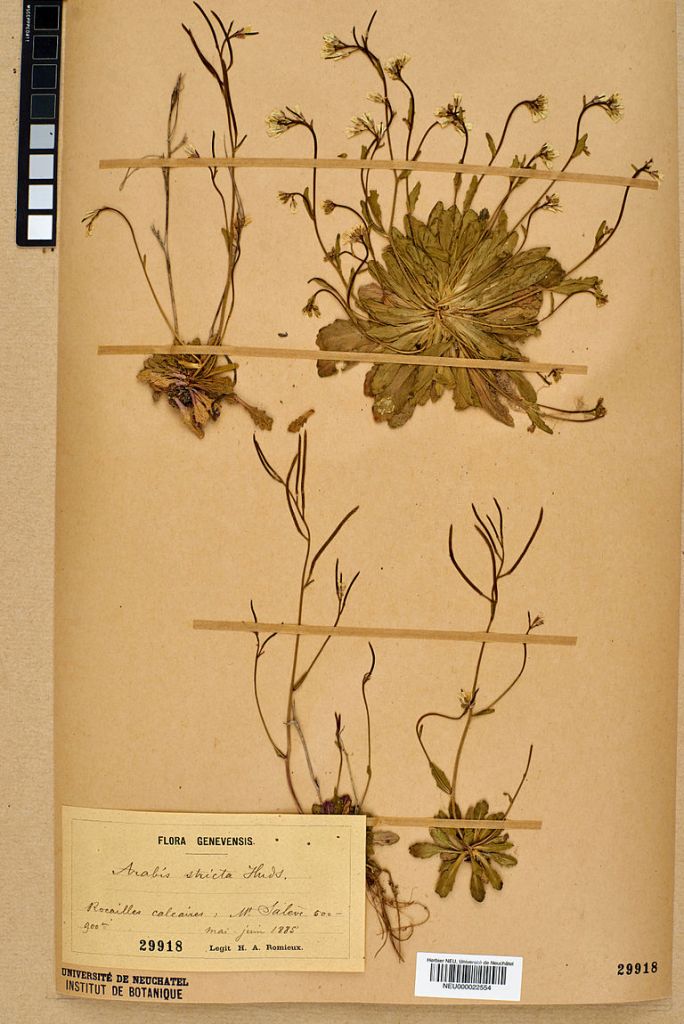
Arabis scabra or Bristol Rock-cress
A short-lived perennial herb of Carboniferous limestone, growing in shallow soils, on scree, and on rock ledges. It spreads by seed.
Also the following species are found in the PlantAtlas 2020 and spread from gardens:
- Arabis caucasica or Garden Arabis
- Arabis collina or Rosy Cress
- Arabis procurrens or Prostrate Rock-cress
Arabidopsis
Arabidopsis petraea or Northern Rock-cress
A perennial herb of very open sites on acidic and basic rocks and rock ledges, on montane cliff faces and screes and on sea-cliffs. It is also found on river shingle and on serpentine fellfield in Shetland.

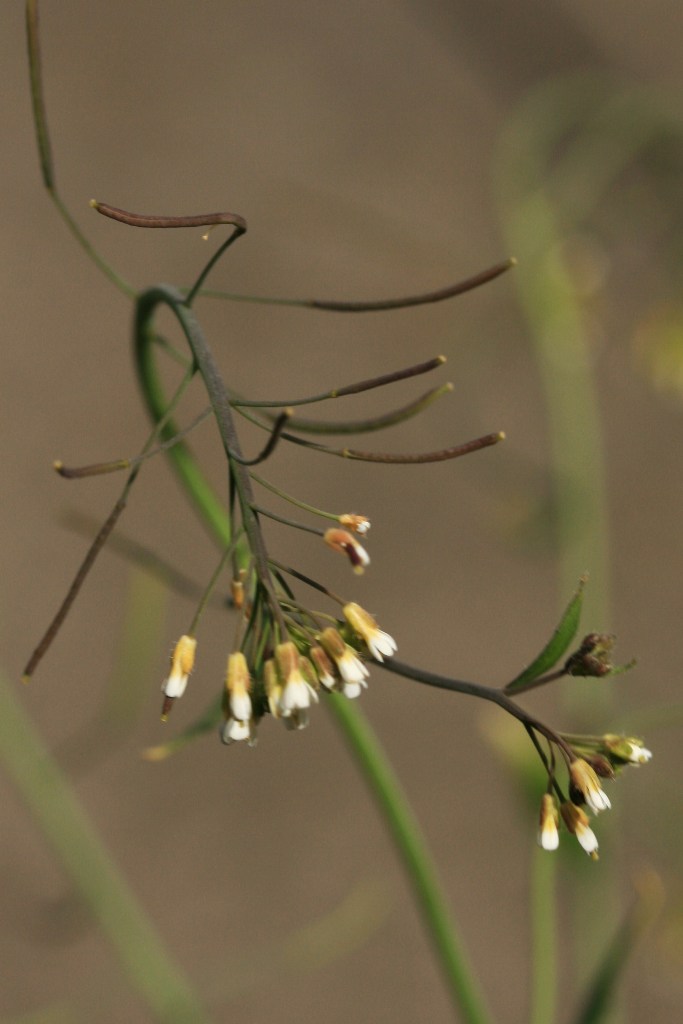
Arabidopsis thaliana or Thale Cress
This winter-annual is a pioneer species, intolerant of competition, which is found on rocky ground, dunes and other open sandy or calcareous habitats. It is also very frequent as a weed in gardens and nurseries, and on all sorts of waste ground, especially by railways.
Multi-national genome project:
A. thaliana is a popular model organism in plant biology and genetics. For a complex multicellular eukaryote, A. thaliana has a relatively small genome around 135 megabase pairs. It was the first plant to have its genome sequenced, and is a popular tool for understanding the molecular biology of many plant traits, including flower development and light sensing.
And neophyte:
Arabidopsis arenosa or Sand Rock-cress
Alliaria
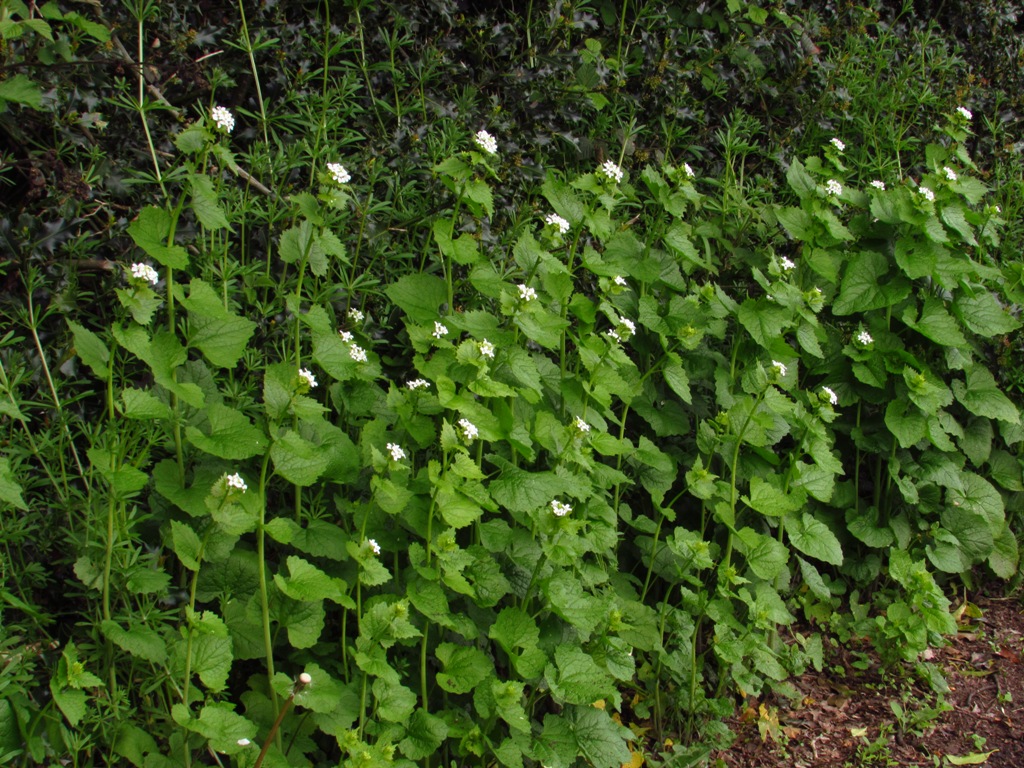
Alliaria petiolata or Jack-by-the-Hedge/ Garlic Mustard
A biennial or monocarpic herb, found in a wide range of habitats including disturbed woodland, woodland edges and clearings, shaded hedge banks, river-banks, the base of walls, road verges, waste ground, farmyards and gardens. It grows especially well on relatively fertile, moist soils, but avoids only the most acidic sites.
- Garlic mustard is one of the oldest spices used in Europe.
- In the 17th century Britain, it was recommended as a flavouring for salt fish. It can also be made into a sauce for eating with roast lamb or salad.
- Early European settlers brought the herb to the New World to use as a garlic type flavouring.
- Today, the chopped leaves are used for flavouring in salads and sauces such as pesto, and sometimes the flowers and fruit are included as well. The leaves, best when young, taste of both garlic and mustard.
- The seeds are sometimes used in France to season food.
- The leaves have been taken internally to promote sweating and to treat bronchitis, asthma and eczema.
- Externally, they have been used as an antiseptic poultice on ulcers etc, and are effective in relieving the itching caused by bites and stings.
- The juice of the plant has an inhibitory effect on Bacillus pyocyaneum and on gram-negative bacteria of the typhoid-paratyphoid-enteritis group.
- The seeds have been used as a snuff to excite sneezing.
- The roots are chopped up small and then heated in oil to make an ointment to rub on the chest in order to bring relief from bronchitis[245].
The leaves and stems are harvested before the plant comes into flower and they can be dried for later use.
Other Uses:
- Its an attractive and easy plant for large scale planting and
- Sixty-nine insect herbivores and seven fungi are associated with garlic mustard in Europe. The most important groups of natural enemies associated with garlic mustard were weevils (particularly the genus Ceutorhynchus), leaf beetles, butterflies, and moths, including the larvae of some moth species such as the garden carpet moth.The small white flowers have a rather unpleasant aroma which attracts midges and hoverflies, although the flowers usually pollinate themselves. In June the pale green caterpillar of the orange tip butterfly (Anthocharis cardamines) can be found feeding on the long green seed-pods from which it can hardly be distinguished.
- The herb was also planted as a form of erosion control.
Draba
Draba incana or Hoary Whitlowgrass
see for more info and pictures in this link
A morphologically variable biennial or perennial tufted herb, which is usually found on limestone rock ledges, screes and pavements, and occasionally in open grassland on thin droughted soils. It also occurs on sand dunes and, more rarely, on base-rich mica-schists and igneous rocks, and on sandstone cliffs.
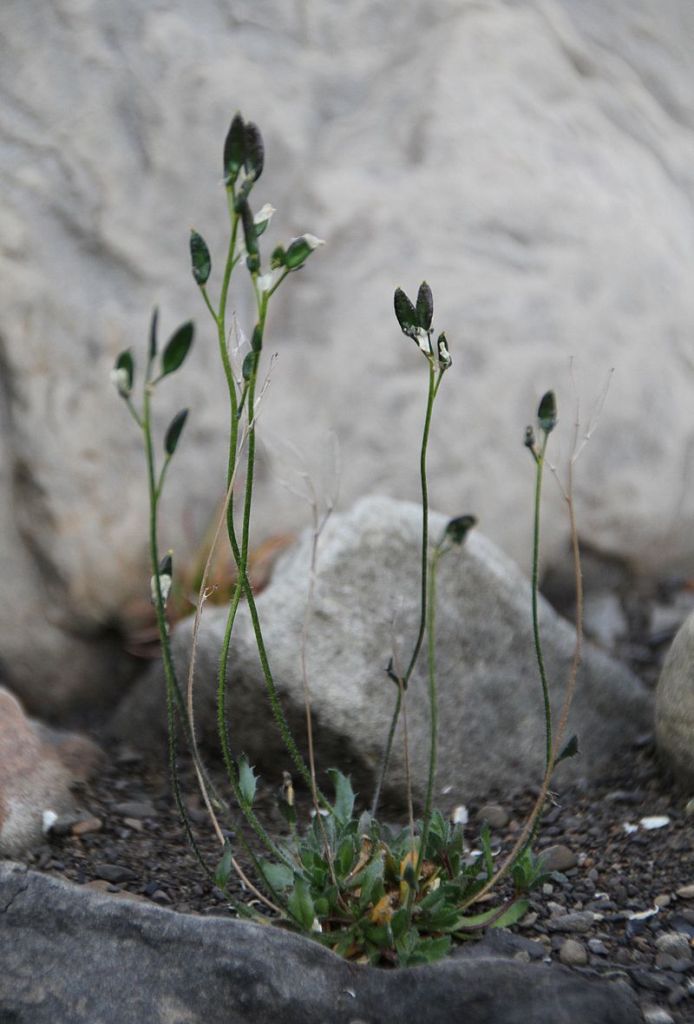
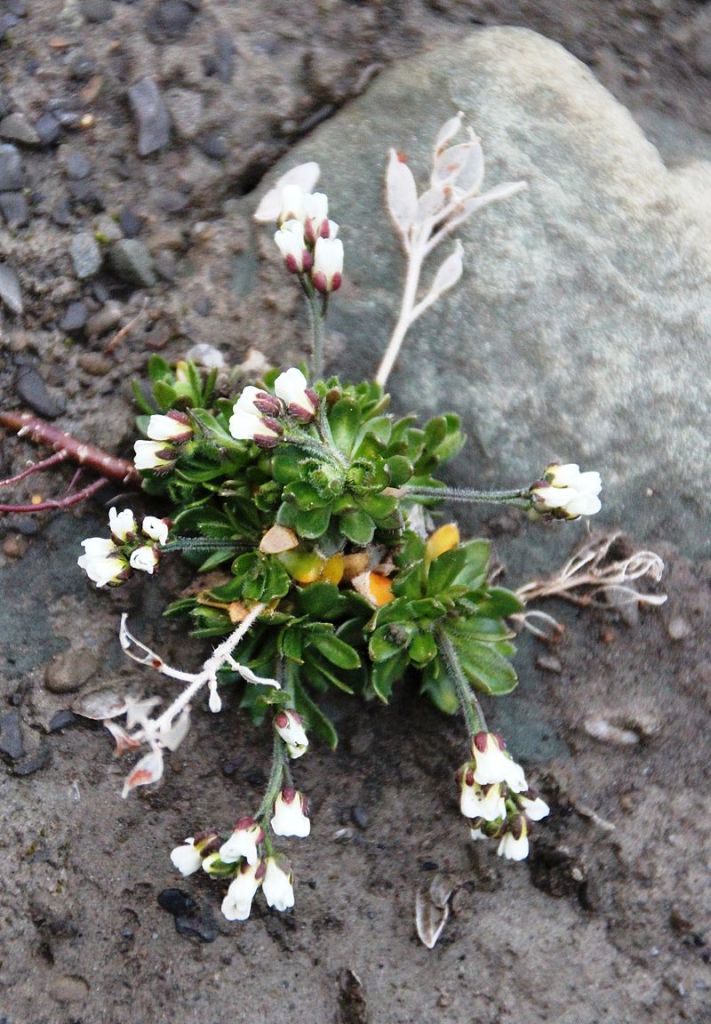
Draba norvegica or Rock Whitlowgrass
A perennial tufted herb of base-rich rocks, occurring on rock ledges, in crevices in cliffs, on consolidated scree and in other bare places. Also see here on UKwildflowers.com
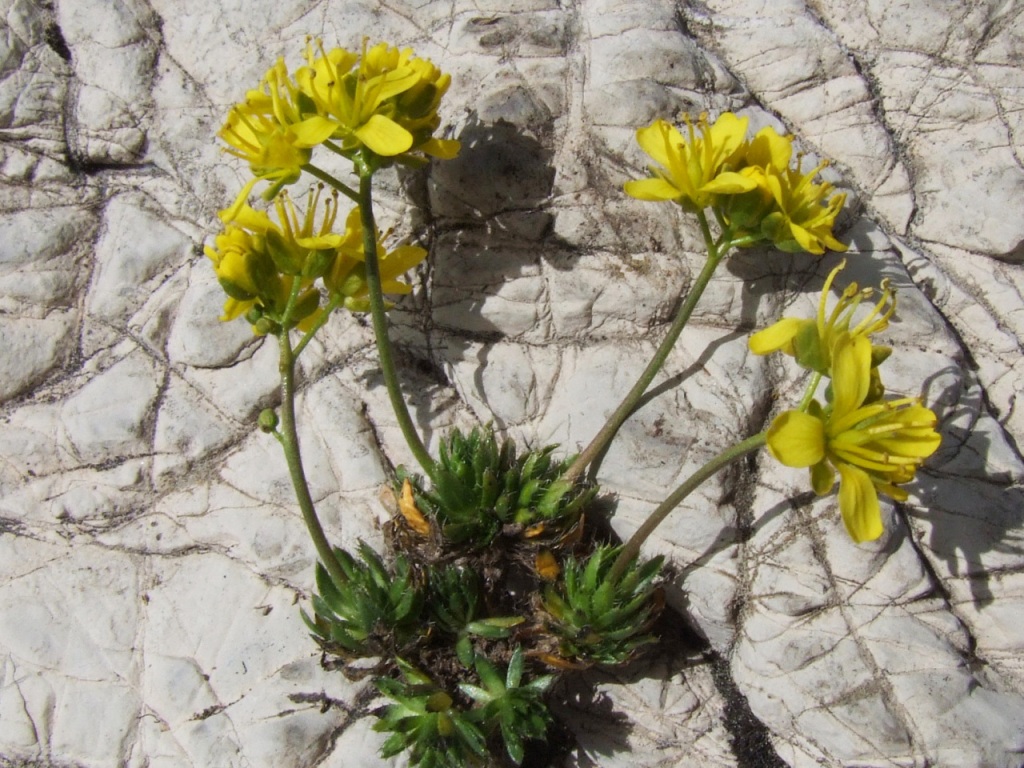
Draba aizoides or Yellow Whitlowgrass
This short-lived, cushion-forming, perennial herb is restricted to limestone rocks, where it grows in crevices in humic calcareous soils.
This plant was first discovered in 1795 in the British Isles, and genetic analysis has shown that the populations in the Gower are quite distinct from those growing in continental Europe, so the plant does seem to be native to Britain. Although its total population is very small, its overall distribution has largely remained stable; plant collectors have removed some plants but the less accessible ones are persisting, although in some sites they have decreased somewhat for reasons that are not clear.
It is a pretty plant and you can obtain seeds from this company here.
Drabella
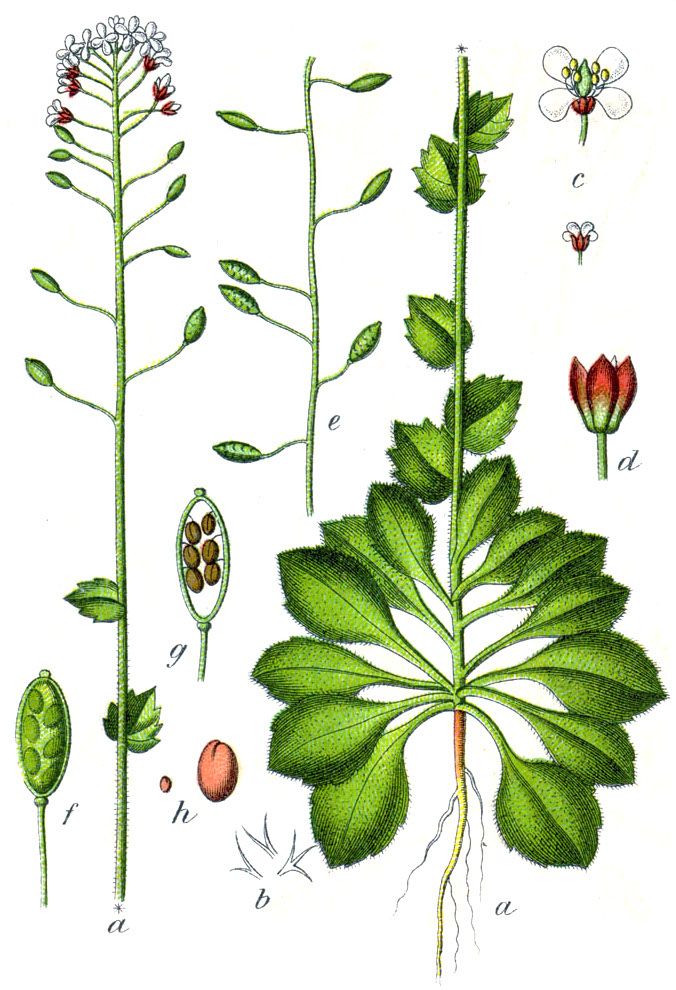
Drabella muralis or Wall Whitlowgrass
This plant is still found under the old name: Draba muralis
A winter-annual, found as a native on limestone rocks on open skeletal soils, and on S.-facing ledges and screes. It is also a colonist on old walls, forest tracks and railways, and has been recorded as a garden weed where the conditions of its summer-dry, winter-moist, native habitat are mimicked.
Group 6: White flowered Crucifers with short fruits
Pepperworts (Lepidium) and Penny-cresses (Thlaspi) both have winged fruits, but Lepidium has one seed per cell (2-5 in Thlaspi)
Thlaspi
Microthlaspi perfoliatum or Cotswold (Perfoliate) Penny-cress
An annual of bare or sparsely vegetated habitats on oolitic limestone, found on screes, stony banks and open pastures; also found in old quarries and on broken rocks.
Young leaves – raw or cooked. A bitter taste and aroma. Added to salads, cooked in soups or used as a potherb, they taste somewhat like mustard but with a hint of onion. The seed is ground into a powder and used as a mustard substitute. The seed can be sprouted and added to salads.

Noccaea caerulescens or Alpine Penny-cress
A perennial, or rarely biennial, herb almost confined in Britain to rocks or soils enriched with lead or zinc, being found on spoil heaps and mine waste and on metalliferous river gravels.
Alpine pennycress has been cited in phytoremediation to have special phytoextractional properties and is known to absorb cadmium with very good results and in certain instances is said to have absorbed zinc as well. Leaves accumulate up to 380 mg/kg Cd.
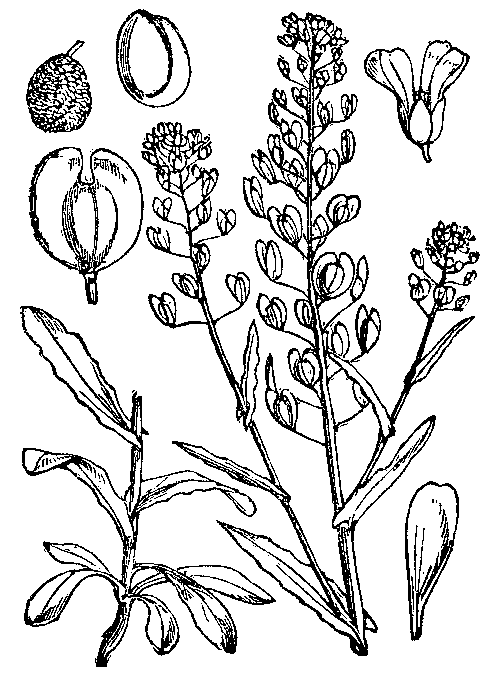
Thlaspi arvense or Field Penny-cress
An annual found as an arable weed, particularly with broad-leaved crops and mainly on heavier soils. It is also a frequent weed on disturbed roadsides, and in waste places and gardens.
- Oil
The first attempts to grow pennycress as an oil crop took place in 1994. However, since 2002 it is more and more considered as a potential oil crop rather than a “noxious weed”. Recently pennycress oil has attracted great interest as raw material for jet fuel and Biodiesel production.
- Feed
Due to the high erucic acid content the seeds are unsuitable for human consumption. Instead, the biomass can be used as feed for livestock. Its fast growth under cold conditions favors the usage as fodder as a second crop.
- Food
The field pennycress has a bitter taste; it is usually parboiled to remove the bitter taste. This is mostly used in salads, sometimes in sandwich spreads. It is said to have a distinctive flavour.
Lepidium
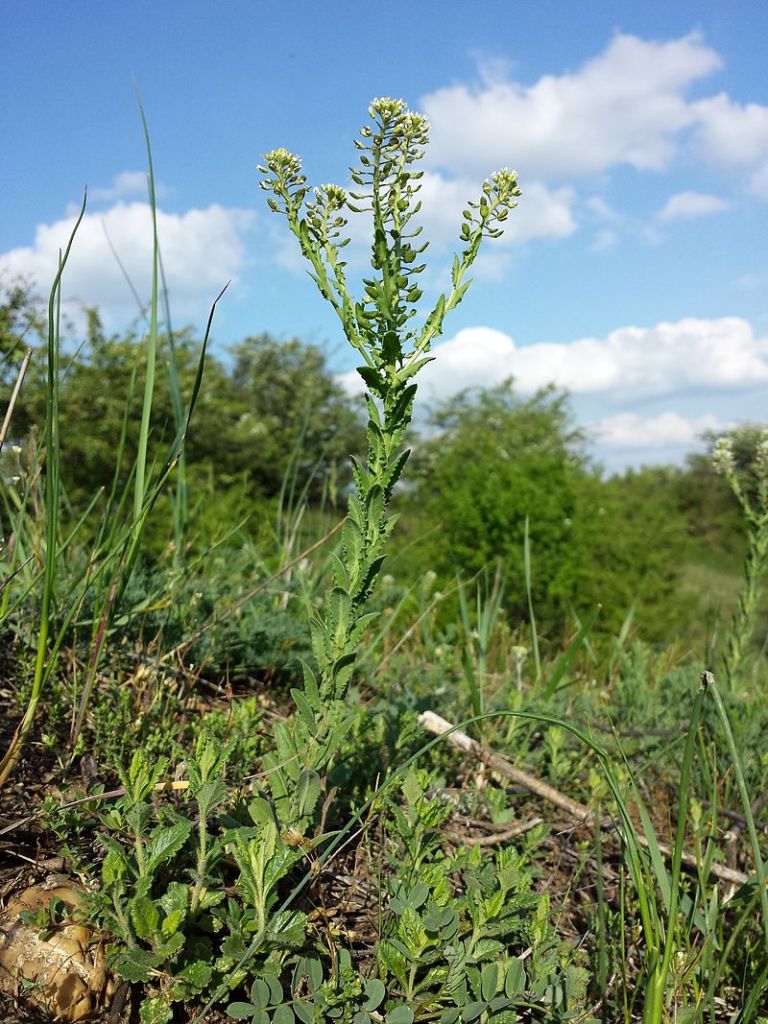
Lepidium campestre or Field Pepperwort
An annual, or occasionally biennial, herb of open grassland and arable fields, particularly on sandy or gravelly soils; also found on roadsides and walls, in gardens and waste places.
The young leaves can be eaten as greens, added raw to salads or boiled for ten minutes. The young fruits and seeds can be used as a spice, with a taste between black pepper and mustard. The leaves contain protein, vitamin A and vitamin C.

Lepidium heterophyllum or Smith’s Pepperwort
A perennial, or rarely biennial, herb of acidic soils in dry heathy and gravelly places. It is also frequent on shingle, railway ballast and embankments, and, less commonly, in arable fields. It is tolerant of grazing.
Probably similar edible uses as above species. It has been used in experiments growing in soils high in copper content, to determine if the plant could be used to help clean contaminated soils.
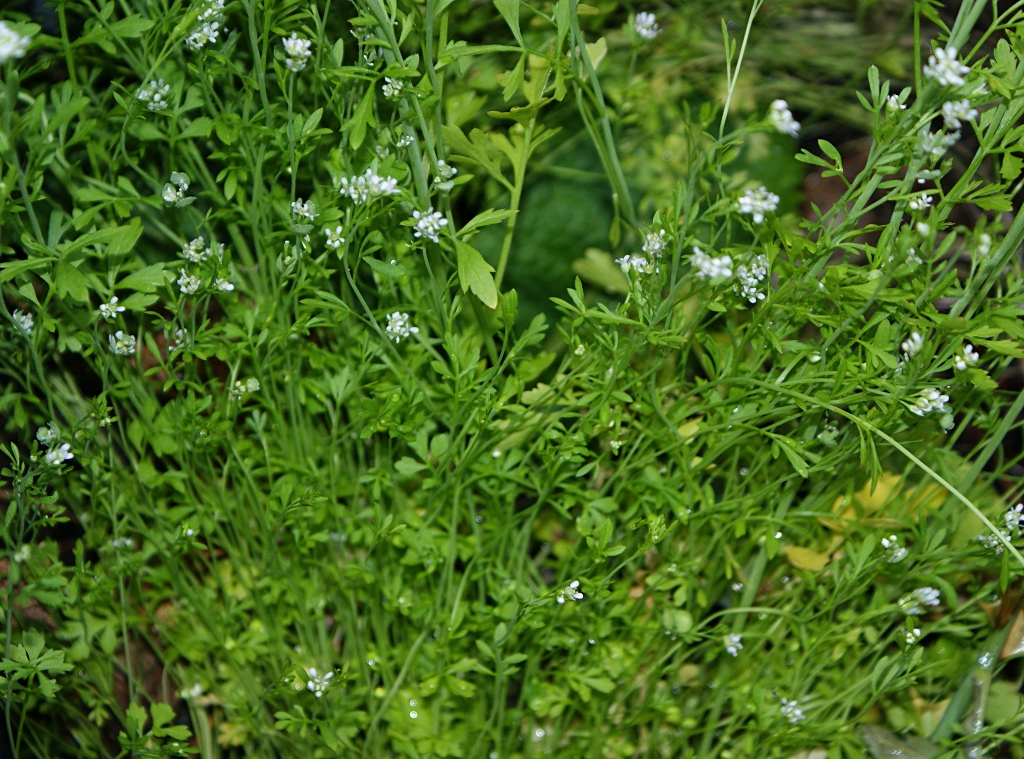
Lepidium sativum or Garden Cress
An annual of waste and ruderal habitats, arising principally from bird-seed and culinary sources, and usually occurring as a casual.
L. sativum has been grown in gardens since at least 995 (Harvey, 1981) and was known from the wild by about 1860. It is the original `cress` of `mustard-and-cress`, but is now very largely replaced in salads by Brassica napus.
Garden cress is added to soups, sandwiches and salads for its tangy flavour. It is also eaten as sprouts, and the fresh or dried seed pods can be used as a peppery seasoning (haloon). In the United Kingdom, cut cress shoots are commonly used in sandwiches with boiled eggs, mayonnaise and salt.
L. sativum is often used in experiments to teach biology to students in schools; the plant grows readily on damp paper or cotton, and its fast germination and development time makes it useful in demonstrating plant growth.
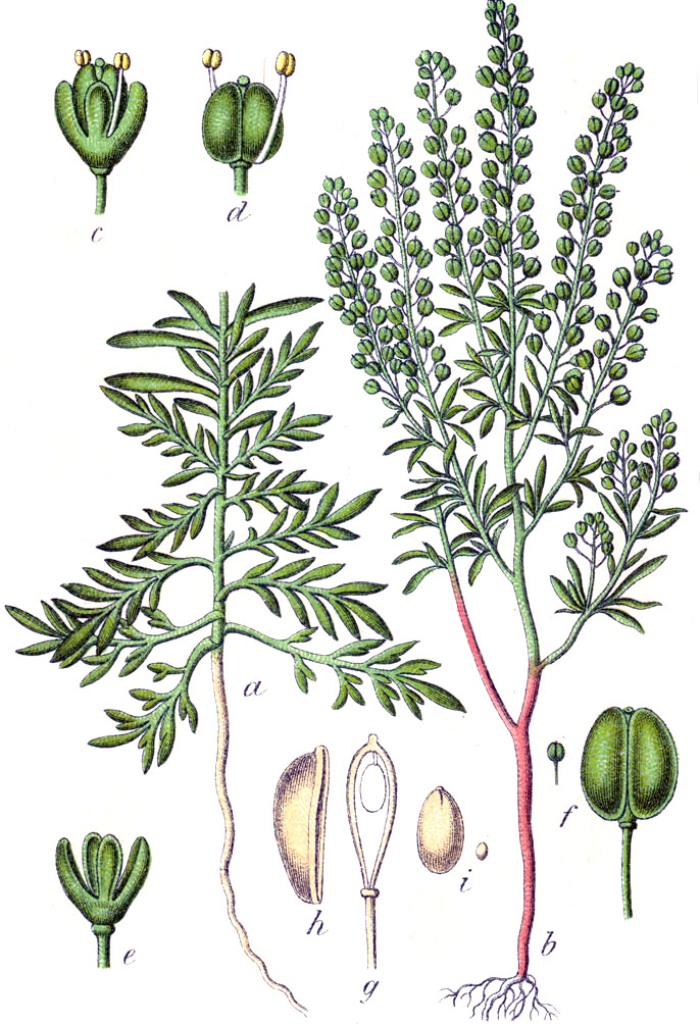
Lepidium ruderale or Narrow-leaved Pepperwort
An annual, or rarely biennial, herb of banks and bare waste land near the sea, and of salted road verges. It is also frequent as a casual of roadsides, rubbish tips, gardens and waste places. Archaeophyte
L. ruderale is increasingly found as a halophyte along trunk roads, but is apparently less frequent as a casual than it was before the Second World War.
Young leaves – raw or cooked. A hot cress-like flavour.
The plant is used in the treatment of impetigo. An aqueous extract of the herb causes a drop in blood pressure and depresses respiration.
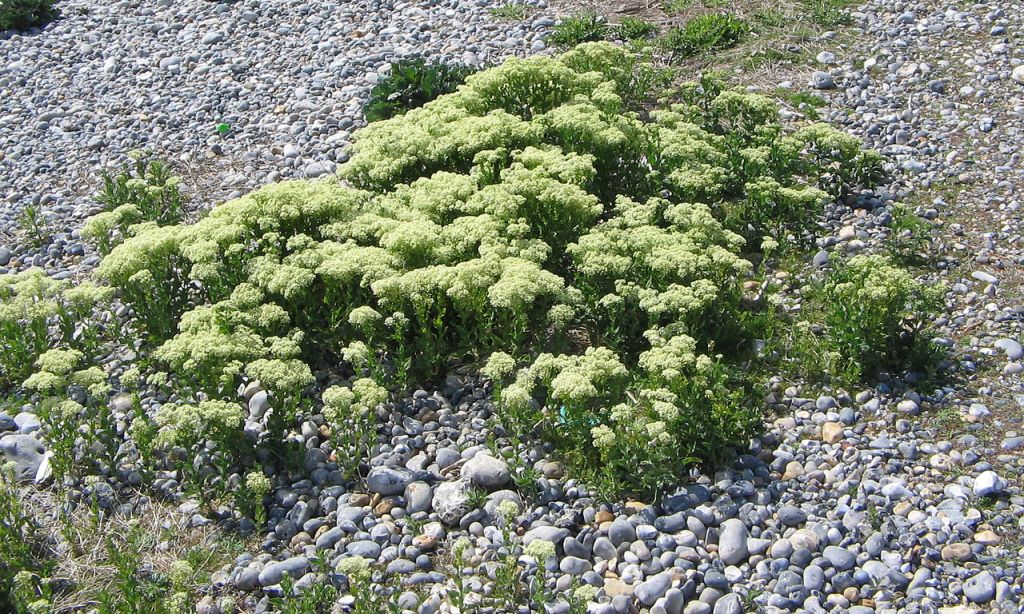
Lepidium draba or Hoary Cress
A perennial rhizomatous herb of roadsides, and on dry limestone or clinker ballast of railways. It also grows on waste ground, in arable fields on light soils, on sand dunes and other sandy ground, particularly near the sea, and in the uppermost zone of saltmarshes. A Neophyte as it was accidentally introduced to Swansea (Glamorgan) in 1802, and subsequently to other ports, L. draba spread rapidly in the 19th century, particularly in urban and industrial areas.
A report says that the young leaves contain the toxin hydrogen cyanide, though does not give any more details. In small quantities this substance is fairly harmless, and has even been recommended as having health benefits, but caution is suggested if you eat these leaves[K].
Young leaves and shoots – raw in salads or cooked as a potherb. The pungent leaves are used as a seasoning. The seed is used as a condiment, it is a pepper substitute.
The plant is antiscorbutic, or anti scurvy, which is caused by lack of Vitamin C. The seeds have been used as a cure for flatulence and fish poison.
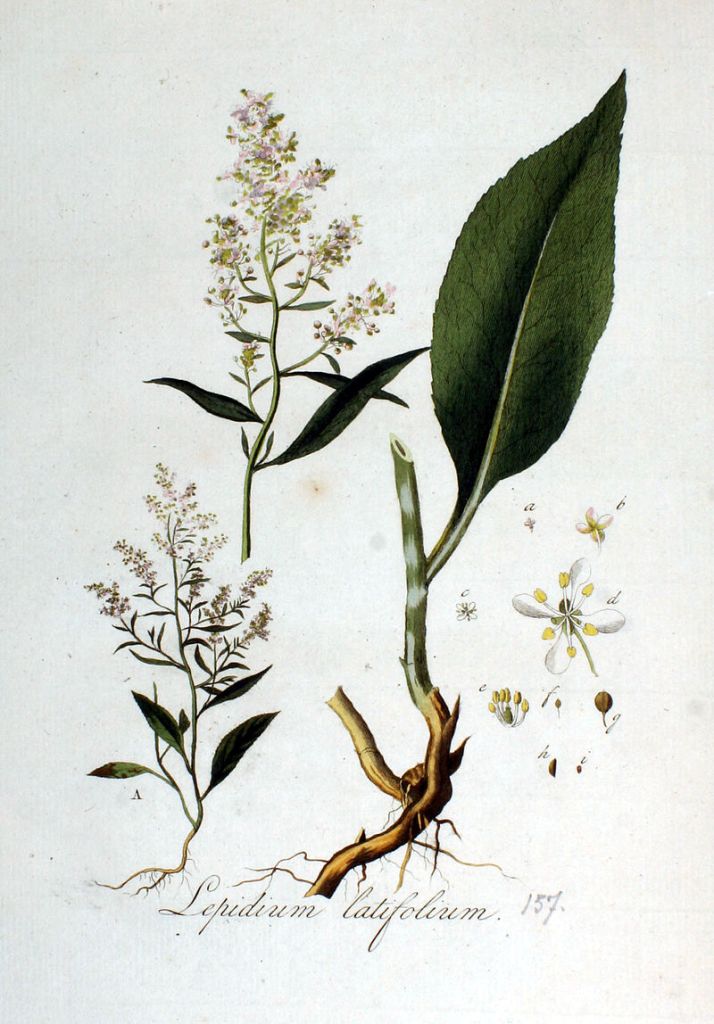
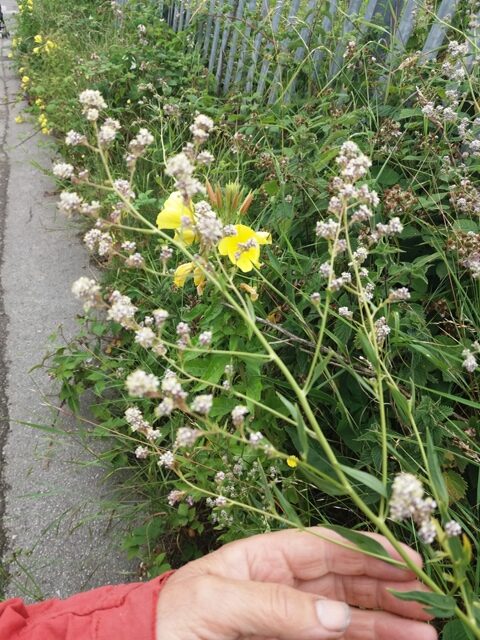
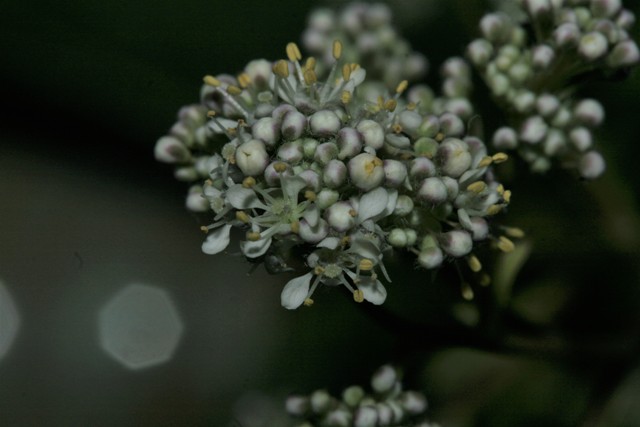
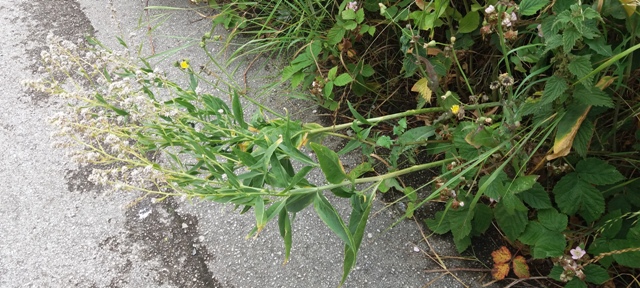
Lepidium latifolium or Dittander
I found this plant for the first time on a railway embankment at my home town. Had no idea what it could be so ask local expert M. Poulton who has seen it in the Birmingham and Black Country area!
A rhizomatous perennial herb native on creek-sides, ditches, sea-walls, open brackish grassland and the upper fringes of estuarine saltmarshes. It is also naturalised in disturbed areas such as waste ground, dockland, railways and roadsides.
Young leaves – raw or cooked. A very hot cress-like flavour[K]. The leaves are nice when used in small quantities as a flavouring in salads[K]. Some reports also suggest using them as a potherb, though they have always seemed to be too strong for us to want to try this[K]. The leaves are available very early in the year[K]. Root – it can be grated and made into a sauce which is used as a horseradish substitute. It has a pungently hot flavour. Seed – used as a condiment
The plant is antiscorbutic, depurative and stomachic. An infusion of the plant is used in the treatment of liver and kidney diseases, it increases cardiac amplitude, decreases frequency and regulates the rhythm. It is also used as a resolvent in the treatment of skin diseases.

Lepidium coronopus or Swine-cress
A spring-germinating annual, rarely biennial, herb of nutrient-rich, often compacted soils in open, dry or winter-wet habitats. Typical sites include farmyards, waste ground, paths and particularly gateways. An archaeophyte.
Nauseously acrid and foetid, requiring much boiling to render them edible. Root – cooked. It was previously used as an alternative to watercress (in salads), but it was deemed such poor quality and only suitable for pigs to eat. It is thought to be slightly tasting of mustard.
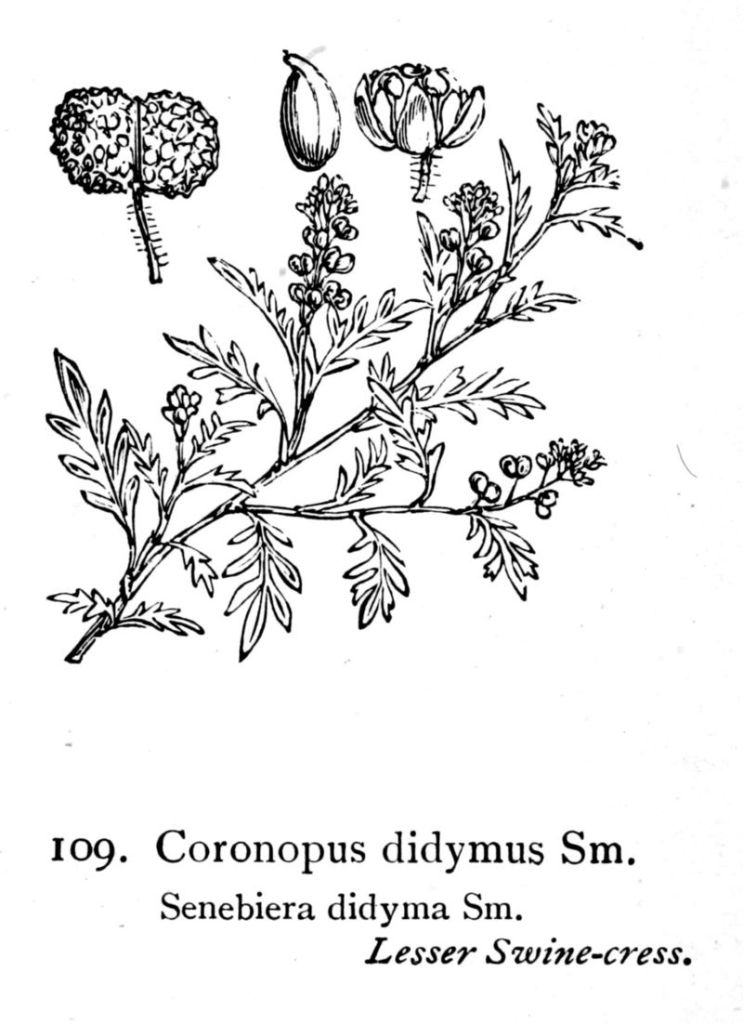
Lepidium didymum or Lesser Swine-cress
An annual or biennial herb of damp, often winter-wet soils, occurring on cultivated and waste ground, and frequently found in gardens and lawns, by paths and roadsides and on rubbish tips. A neophyte, it reached Britain in the early 18th century, being recorded from the wild by 1778.
The leaves of this plant are edible, and have a salty, cress or mustard flavour.
Medicinal tests on Lesser Swine Cress show it to have anti-inflammatory properties.
Teesdalia
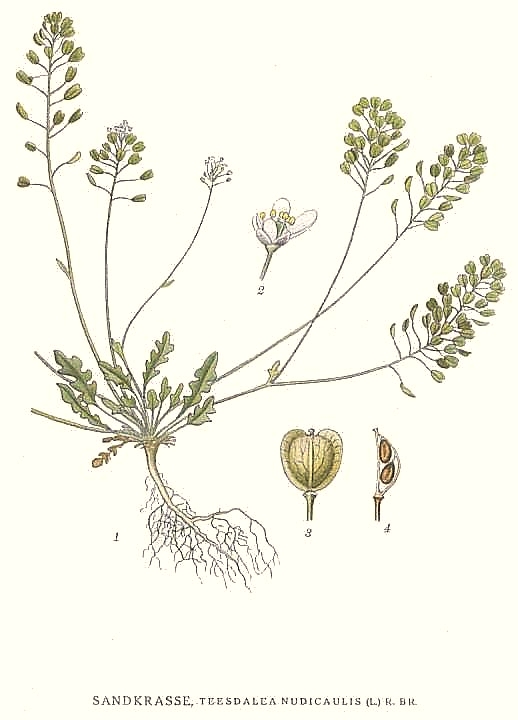
Teesdalia nudicaulis or Shepard’s Cress
A winter-annual of acidic, well-drained sandy soils on heathlands, sand dunes, shingle and gravels, on sandy lake shores in Ireland, by railways and on coal and cinder tips. It prefers bare or disturbed ground.
Capsella

Capsella bursa-pastoris or Shepard’s-purse
An annual, germinating throughout the year in suitable conditions and ubiquitous in many disturbed and nutrient-rich habitats. It is abundant on waste ground and in gardens, and is frequent in cultivated fields, particularly amongst broad-leaved crops. It avoids the wettest and most acidic soils. It has a very long-lived seed bank.
- The young leaves, used before the plant comes into flower, make a fine addition to salads.
- The leaves are a cress and cabbage substitute, becoming peppery with age.
- The young flowering shoots can be eaten raw or cooked. They are rather thin and fiddly but the taste is quite acceptable. They can be available at most times of the year.
- Seed – raw or cooked. It can be ground into a meal and used in soups etc.
- The oil in the seed can be extracted and is edible.
- The seedpods can be used as a peppery seasoning for soups and stews.
- The fresh or dried root is a ginger substitute
Shepherd’s purse is little used in herbalism, though it is a commonly used domestic remedy, being especially efficacious in the treatment of both internal and external bleeding, diarrhoea etc.
- A tea made from the dried herb is considered to be a sovereign remedy against haemorrhages of all kinds – the stomach, the lungs, the uterus and more especially the kidneys.
- It has proven uterine-contracting properties and is traditionally used during childbirth.
- The plant is a folk remedy for cancer – it contains fumaric acid which has markedly reduced growth and viability of Ehrlich tumour in mice.
- A homeopathic remedy is made from the fresh plant. It is used in the treatment of nose bleeds and urinary calculus. (The German Commission E Monographs, a therapeutic guide to herbal medicine, approve Capsella bursa-pastoris Shepherd’s Purse for nose bleeds, premenstrual syndrome, wounds & burns.)
There is also a:
Pink Shepherd’s-purse or Capsella rubella which is a neophyte.
Iberis
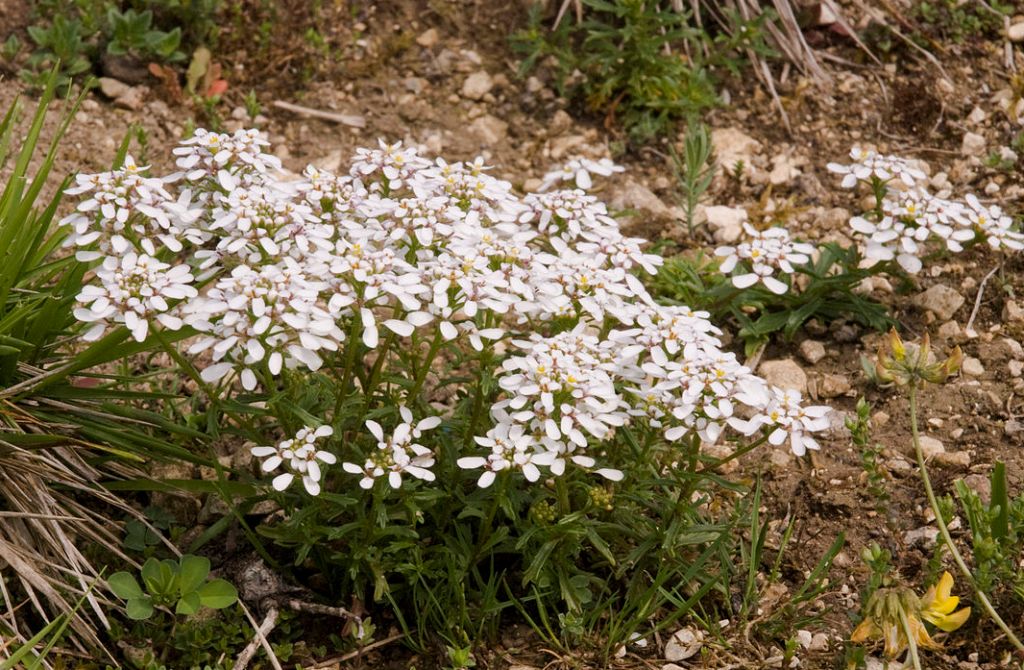
Iberis amara or Wild Candytuft
An annual, rarely biennial, herb of bare, open ground on S.-facing slopes on chalk, being found in bare places in grassland, particularly rabbit scrapes, and in quarries. It also occurs as an arable weed, and as a casual in a wide variety of ruderal habitats.
Attractive annual with sweet scented flowers.
The seeds are sometimes used as a source of mustard. Pungency of mustard develops when cold water is added to the ground-up seed – an enzyme (myrosin) acts on a glycoside (sinigrin) to produce a sulphur compound. The reaction takes 10 – 15 minutes. Mixing with hot water or vinegar, or adding salt, inhibits the enzyme and produces a mild bitter mustard.
The seeds are considered very useful in the treatment of asthma, bronchitis and dropsy. The plant is gathered in the summer and can be dried for later use. The seeds are harvested when fully ripe. A common homeopathic remedy is made from the seeds.
also see:
Erophila
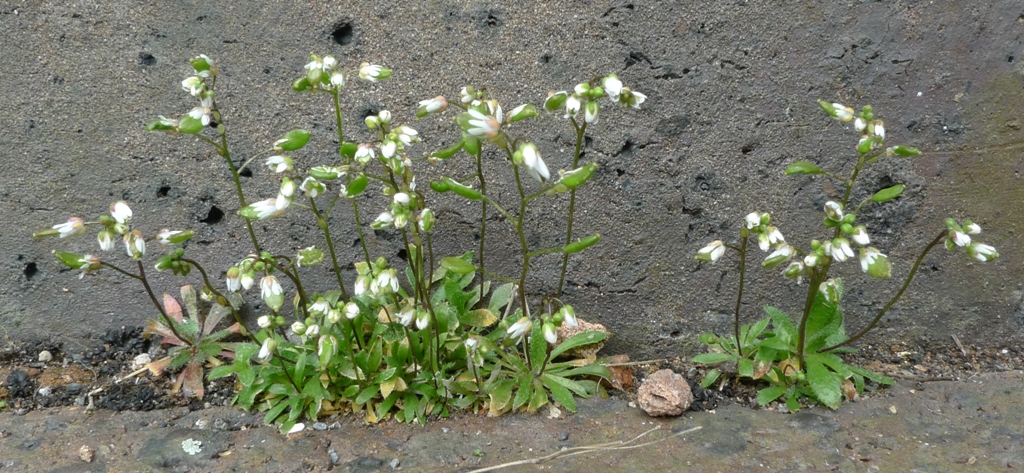
Erophila verna or Common Whitlowgrass
Typical semi-natural habitats of E. verna include limestone cliffs and pavements, sand dunes, sandy banks and coastal and riparian shingle. It is also frequent in quarries, sand- and gravel-pits and on lime-mine spoil heaps, walls, railway clinker, rubble and waste ground and cracks in pavements.
The species was used to treat whitlow infections
Cochlearia
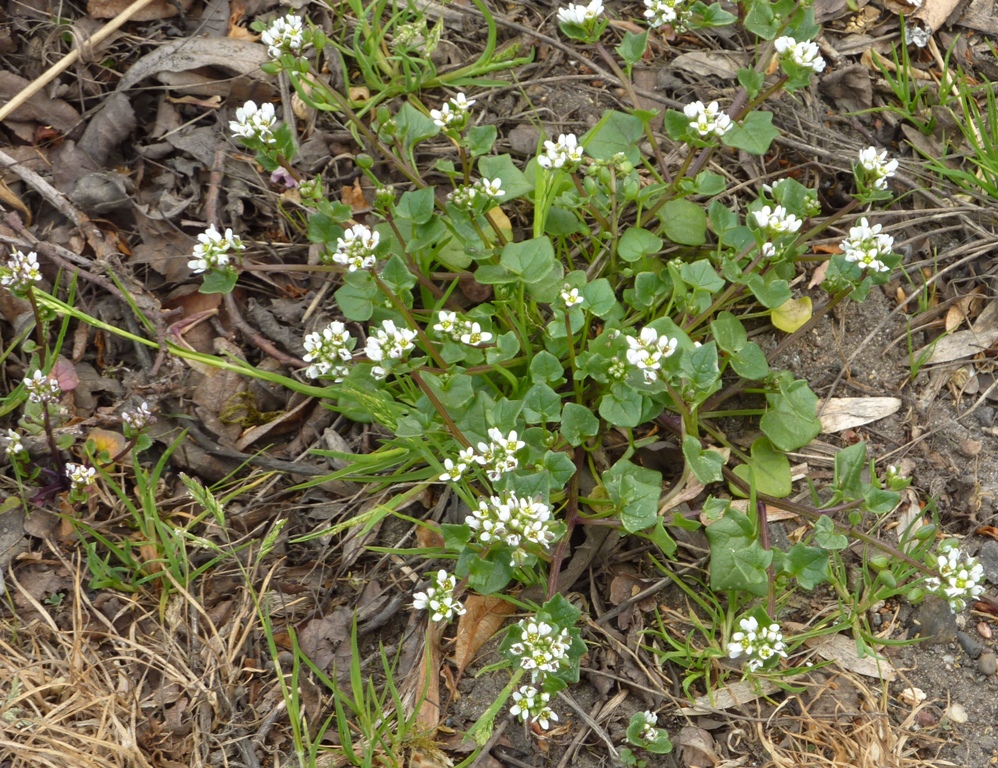
Cochlearia officinalis agg or Common Scurvygrass
Biennial or perennial herbs found in a range of moist, open, coastal and montane habitats. They also grow on hedge banks, for example in S.W. England and Wales, but are only occasional recent colonists of salted roadsides.
Leaves – raw. An acrid tarry flavour, it can be added in small quantities to salads for its high content of vitamin C. Pleasantly sharp. Rather less than pleasant to most tastes, though there are occasional people who like it[K].
This plant was highly valued by sailors of the past and was taken in the diet daily as a preventative for scurvy on long sea trips. Applied externally, the bruised leaves are used to heal ulcers.
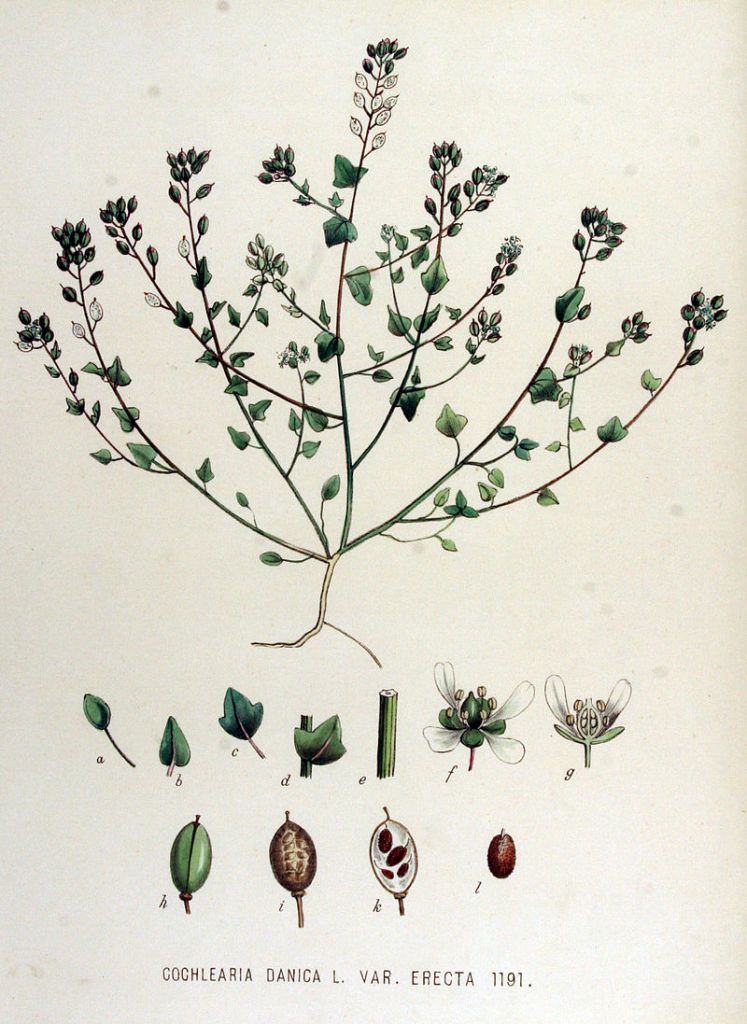
Cochlearia danica or Danish scurvygrass
A winter-annual of cliff-tops, sand dunes and sea-walls, and on old walls and pavements in coastal towns; generally preferring open ground on well-drained sandy soils or bare rock.
Since the early 1980s, C. danica has spread rapidly along salt-treated roads in Britain and N. Ireland, but not in S. Ireland where grit is used. A former preference for the central reservations of motorways and dual carriageways is becoming less obvious, and it now occurs on many single-carriageway A roads in England and Wales.
Similar as Common Scurvygrass: it is rich in Vitamin C. Leaves are used as a flavouring in salads, it is considered to be superior to C. officinalis.
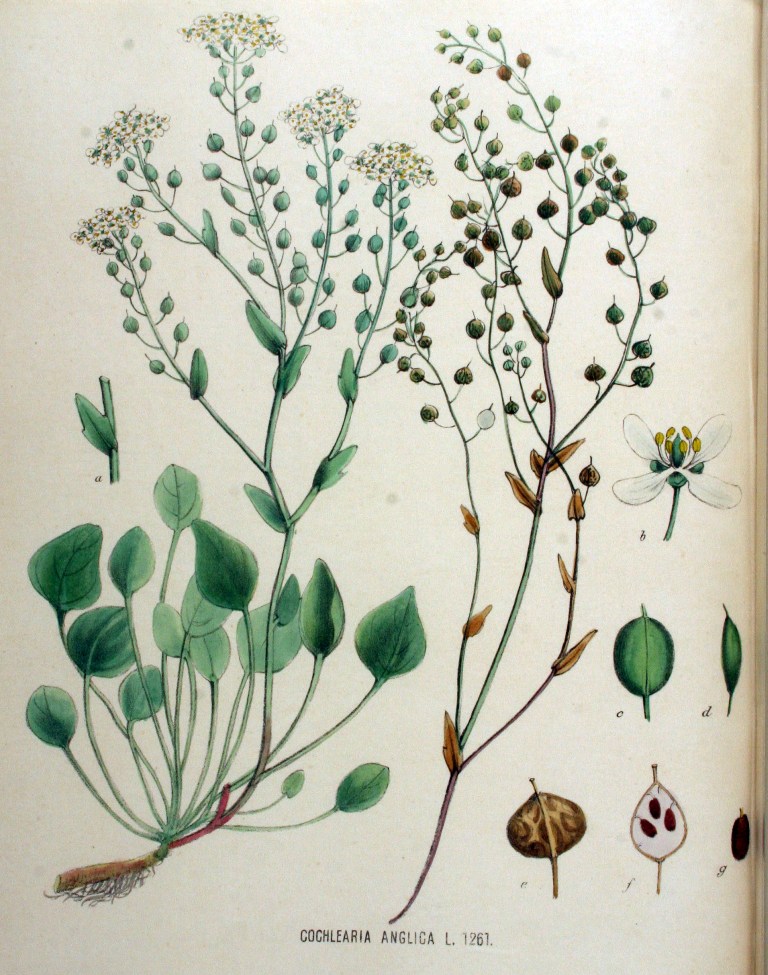
Cochlearica anglica or English Scurvygrass/ Long-leaved Scurvygrass
A biennial to perennial herb found in saltmarshes on soft, silty substrates, and in firmer areas of mud (and on sea-walls) near the high water mark of estuaries and tidal rivers. Unlike C. officinalis and C. danica, it is not found by roads.
Like the 2 species above. Young leaves and flower heads – raw. Bitter[K]. Used as a flavouring in salads.
Also found in Plant Atlas 2020:
- Cochlearia acaulis or Violet Cress
- Cochlearia megalosperma or Tall Scurvygrass
- Cochlearia micacea or Mountain Scurvygrass
- Cochlearia pyrenaica or Pyrenean Scurvygrass
- Cochlearia officinalis subsp. scotica or Scottish Scurvygrass
Lobularia
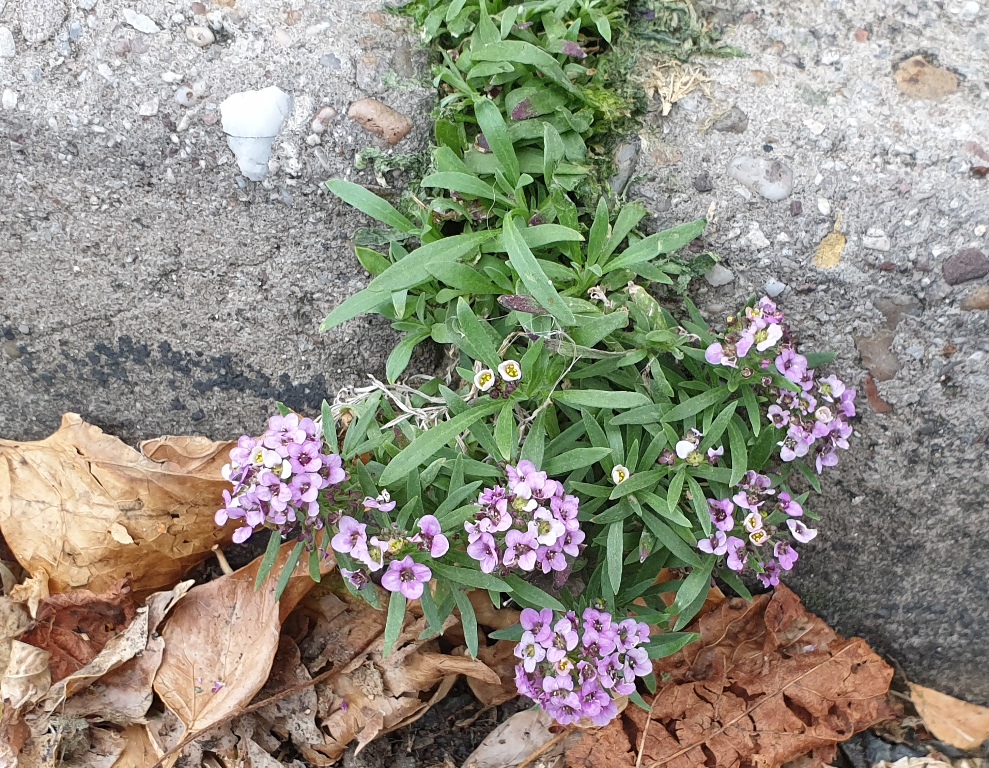
Lobularia maritima or Sweet Alison
An annual, biennial or perennial herb, naturalised on sea-cliffs, sand dunes and open ground near the sea, and occurring as a casual inland in a variety of waste ground habitats.
This plant is a neophyte, often a garden escape. Have seen this surviving for at least 3 years as a perennial at Brownhills Activity Centre. Originally planted in small borders as an annual!
- Lobularia maritima is cultivated in gardens, with many horticultural varieties with purple or pink flowers.
- The petals, leaves, and tender stems of the plant can be eaten raw or cooked.
Hornungia
Hornungia petraea or Hutchinsia
A winter-annual of very open habitats on calcareous soils and rocks which are subject to summer drought, especially on rocky slopes on Carboniferous limestone and on fixed but open sand dunes.
Hutchinsia is named after the Irish botanist Ellen Hutchins (1785 to 1815) who made great progress in the discovery and understanding of lichens and mosses in the area of Bantry bay where she lived.
Group 7: White flowered Crucifers with very large leaves
Crambe
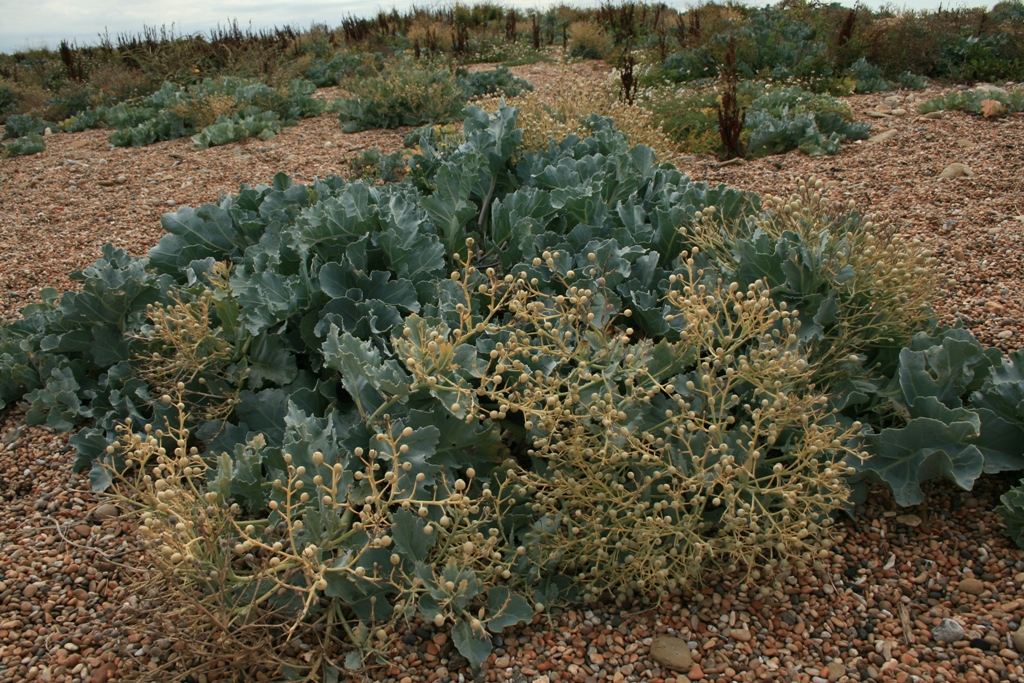
Crambe maritima or Sea-kale
A long-lived perennial herb of shingle and boulder beaches, very occasionally found on dunes (but only where these overlay shingle) and on cliffs. It reproduces by seed and from detached pieces of root.

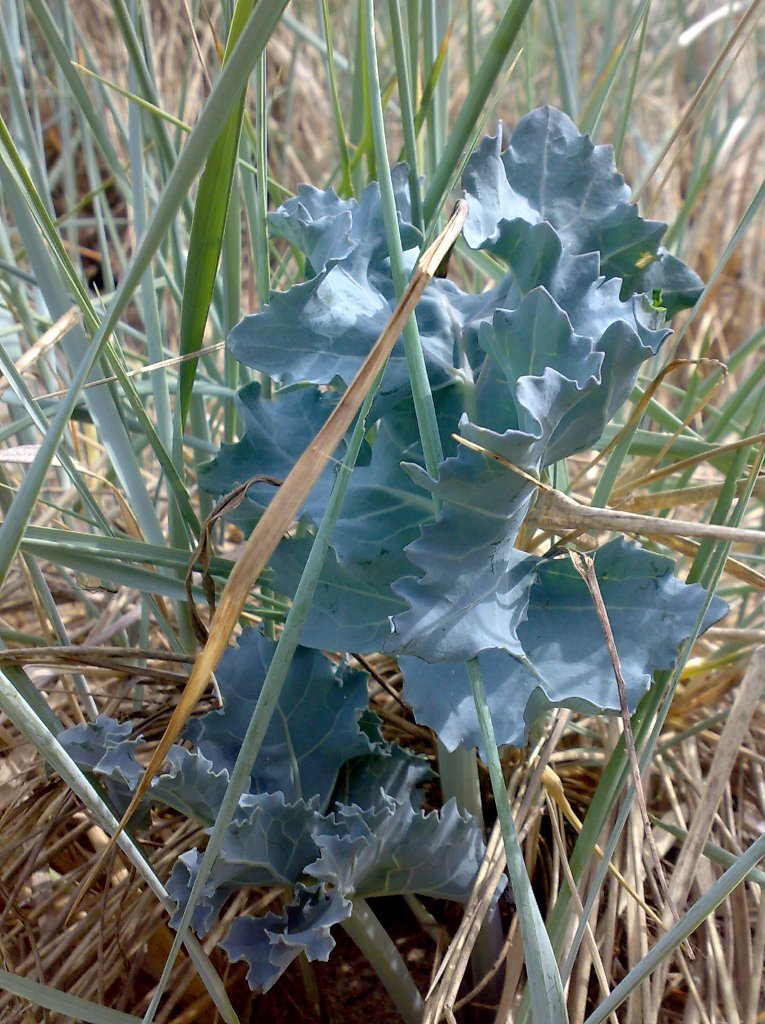
There are records from the 18th century of local people along some coasts of England digging out and harvesting the emerging shoots as a vegetable from naturally occurring root crowns in the early springtime. This custom was first reported by Phillip Miller in his 1731 Gardener’s Dictionary as practised among the indigenous peoples of Sussex, and it was seen once in the 18th century being sold as food, this at the Chichester market in 1753. John Martyn was the first to publish some practical notes on cultivating the plant in a late edition of Miller’s work, but William Curtis was the first to publish a tract about his experiments of growing the plant as a vegetable crop in London in 1799, just before his death, with John Maher giving a reading before the Horticultural Society of London in 1805 which elaborated slightly on the work of Curtis. Both Curtis and Maher recommended growing the plant as a forced, blanched vegetable, growing the rootcrown in a ceramic cylinder which could be capped with a closed blanching pot.
- Young leaves – raw or cooked like spinach. They have a pleasant almost nutty flavour and go well in a mixed salad[K]. They also make a very pleasant cooked vegetable[K]. Older leaves develop a bitterness and are not so pleasant[K].
- Young shoots – raw or cooked. Available in the spring, they have a delicate nutty flavour with a crisp texture. The shoots are usually blanched and can be cooked like asparagus. When properly cooked they retain their crispness and have a very agreeable flavour, somewhat like hazelnuts but with a slight bitterness.
- Root – cooked. Rich in starch and sugars.
- Young flower buds – raw or cooked[264]. The flowering shoots are harvested when about 10 – 15cm long and before the flowers have opened. Used like sprouting broccoli, they are quite nice raw and delicious when lightly steamed[K].
Armoracia
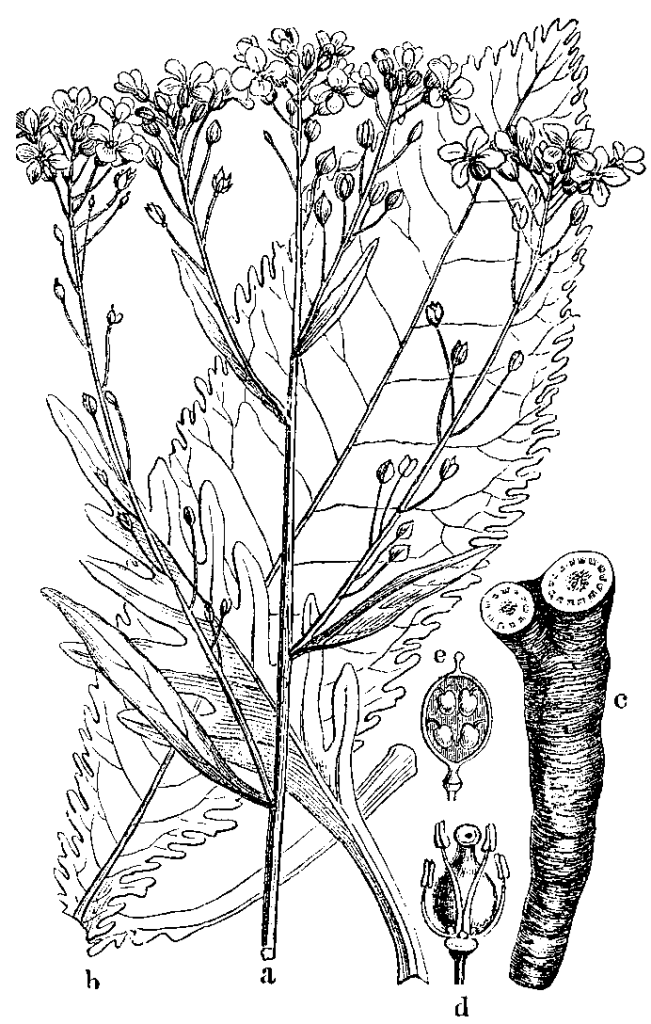
Armoracia rusticana or Horse-radish
A long-lived perennial herb, persisting in old gardens and allotments and spreading by root fragments to roadsides, waste ground, railways, sandy seashores and river-banks. The plant is highly sterile, and seed-set is unknown in our area.
It is known as an archaeophyte as it was introduced before 1500, initially as a medicinal herb, but by 1650 it had replaced Lepidium latifolium as a vegetable cultivated for hot relishes.
Horseradish sauce made from grated horseradish root and vinegar is a common condiment in the United Kingdom and in Poland. In the UK, it is usually served with roast beef, often as part of a traditional Sunday roast, but can be used in a number of other dishes, including sandwiches or salads.
It should not be used internally by people with stomach ulcers or thyroid problems.
Medicinal Uses:
- Horseradish is a very pungent stimulant herb that controls bacterial infections and can be used both internally and externally.
- The plant is a powerful stimulant, whether used internally as a spur for the digestive system or externally as a rubefacient.
- An infusion is used in the treatment of colds, fevers and flu and is of value in the treatment of respiratory and urinary tract infections.
- A sandwich of the freshly grated root is a traditional remedy for hay fever.
- A tea made from the root is weakly diuretic, antiseptic and expectorant.
- The plant is antibiotic against gram-negative and gram-positive bacteria and also pathogenic fungi.
- It is experimentally antitumor.
- Externally, a poultice made from the roots is used to treat pleurisy, arthritis and infected wounds.
- It will also relieve the pain of chilblains. Some caution should be employed, however, because it can cause blistering.
